#but i wrote for a bunch of other characters recently so its kind of cool to see
Explore tagged Tumblr posts
Text
10 First Lines
Rules: Share the first line of your last ten published works or as many as you are able to and see if there are any patterns!
Thanks for tagging me @im-not-buying-it-ether!
1. Pretty Little Thing: No one was going to save him.
2. A Day Worth Celebrating: Captain Marvel gently landed on the ground, holding the trembling figure of Beautia Sivana in his arms.
3. A Mind Of His Own: Billy sat dejectedly in the corner booth of Pop’s Place, staring out of the window without really paying attention to anything happening on the other side of the glass.
4. The Lies We Tell Our Children (Are the Ones We Tell Ourselves): Chaos.
5. Blinding Light: Duke opened the door as quietly as he could.
6. The Legend of Nightwing and Flamebird: On Krypton there were few stories as timeless as that of Nightwing and Flamebird.
7. Metamorphosis: “Can I tell you a secret?”
8. The Freedom of Mercury: There was no freedom greater than that of feeling the wind in your hair.
9. The Fearlessness of Achilles: Courage was not the same as fearlessness, but rather the ability to persevere despite one’s fears.
10. The Judgement of Zeus: Not everyone could handle true power.
I'm not sure if I see any patterns here except maybe that I like somewhat abstract opening lines (though for the last three that was intentional).
I'll tag a couple people but if you see this and want to join in you should totally do it!
@stormnox , @billy-and-friends , @puppetwoman17 @penny-anna and @cerealboxlore
#ask me whatever you want y'all#ask game#this is so fun#i love that the longest title here has the shortest sentence#shazam#billy batson#dc captain marvel#im surprised#that only half of these are about Billy#but i wrote for a bunch of other characters recently so its kind of cool to see
36 notes
·
View notes
Text
Animation Night 189: Nonphotorealistic
There is a funny trend in animation-related terminology to define things by what they aren't. Animation is any technique for creating film that isn't live action. Limited animation is any style of 2D animation that doesn't follow the conventions of Disney's 'full animation' on 1s and 2s - a category that includes a wildly diverse range of approaches and techniques, as this wonderful history by Animation Obsessive describes.
In 3DCG circles, there is a similar term: nonphotorealistic. Which describes, naturally, anything that isn't trying to look like a photograph of a real scene. There has been a real boom in this of late, and just like the other terms, it really doesn't narrow it down very much. Other terms like 'hybrid animation' add a bit more hints.
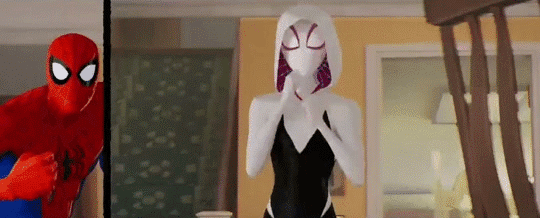
Of course, if you've been anywhere near animation in the last few years, you'll probably know another term: 'Spiderverse style'.
There is no denying that Spider-Man: Into the Spiderverse (2018) by Sony Pictures Animation was an absolute landmark for animation. (I wrote about it way back on AN21, focusing more on the cultural angle.) The ludicrously stylish film pretty much set the direction for animation in the 2020s - making a bunch of money and awards and thus finally throwing open the door to 3DCG animation that doesn't look like the style set by Pixar/Dreamworks in the 2000s. Its sequel, Across the Spiderverse (2023), was even more ambitious and successful (despite a troubled production involving a lot of needless crunch). We'll be showing that soon in a Spiderverse double bill so look forward to it!
So perhaps not surprising that when people see the use of graphical styles, 2D elements, limited framerates and the like in 3DCG these days, Spiderverse comes to mind. In its wake have come various films and series that apply these and related techniques: 3DCG animation is more varied than ever, and it's cool.
It isn't really a style, tho.
youtube
Here I'm indebted to youtuber Camwing who has made a nice video overview breaking down the animation of recent movies in this vaguely defined paradigm. Among them we have The Mitchells vs the Machines (2021, also Sony), Puss in Boots: The Last Wish (2022, Dreamworks), and Teenage Mutant Ninja Turtles: Mutant Mayhem (2023, animated at the French/Canadian studio Mikros animation), and of course over on Netflix you got the wildly popular League of Legends spinoff series Arcane (2021, Fortiche Productions), and the romance film Entergalactic (2022, DNEG), tying in with an album of the same name.
None of these films has exactly the same style, but they all pull from a related bag of tricks. The core techniques are animating on reduced framerates for a 'snappy', high-clarity feeling, the combination of 2D and 3D elements in some fashion, and taking inspiration from traditional media such as paintings or comic books.
For example, Arcane and Entergalactic both use the trick of 2D backgrounds/projecting paintings onto 3D geometry, inhabited by 3D characters with a stylised shader. Arcane is dripping with 2D visual effects. Puss in Boots drops the framerate during its action scenes - the opposite of the old paradigm of full animation, where fast actions would get more frames. Spiderverse draws 2D expressions onto its 3D models to push them further, and is full of all kinds of colourful stylised rendering - screentone effects, kirby dots, outlines, the works.

It's tempting to link this to 2D-in-3D animation, and certainly many of these films apply this technique - this is the major niche where Blender has found its way into industry pipelines. But using 2D isn't mandatory to count here. For example, TMNT Mutant Mayhem has an incredibly striking storybook-painting style, accomplished largely by clever shader work and a strong sense of graphic design. Genndy Tartakovsky's canned 2014 Popeye project was planning to use a ton of 2D-style posing and squash-and-stretch, accomplished largely with rigged 3D models. There are many paths to take!
And mind you, I haven't even covered one of the biggest angles here. Search for nonphotorealistic 3DCG on Youtube and what you'll probably find most is information about cel-shading - aka 'anime style'. This has also advanced considerably in the last few years, with the techniques pioneered by Arc System Works in Guilty Gear such as editing the normals of characters for more precise control over shading, and minute adjustments to break up the mechanical feeling of 3D, becoming widely copied in both games and films. (And particularly, animated porn.)
youtube
Vtubers in particular have really run with this technique, generally speaking using cel-shaded models with edited normals, inverted eyes, etc. etc. to try and get the feeling of an anime character come to life. [You can see a lot of these state of the art techniques if you download Pixiv's free VRoid Studio software and import the model into Blender using the VRM plugin.]
Naturally this kind of cel-shaded approach has found a particular home in Japan. In anime, the biggest champions of it are certainly Studio Orange, whose hybrid approach involves planning out shots with 2D animation before matching them with the rigs. We've covered their adaptation of Houseki no Kuni in great detail on Animation Night 97; their Trigun reboot was perhaps even more popular. But cel-shaded techniques, 3D previs and the like have also made their way into big films like Eva 3.0+1.0 (AN66).
Although this type of rendering aims to recreate the look and feel of 2D animation as much as possible, it always ends up being something new: character models that would be too complex to draw, an ease to 3D movements and camerawork that would be challenging in 2D, and generally a new hybrid style. This is good! 2D animation is already very good at being 2D animation - it's fascinating to see what 3DCG becomes with that inspiration.
So with that brief overview, where does that take us tonight?
I'm not quite ready to do a Spiderverse double bill tonight, so instead the plan is to check out a couple of recent American franchise films that are taking on the new suite of techniques. I've mentioned them up above, but let me introduce them more fully here.

Puss in Boots: The Last Wish is a sequel to a fairly unpopular spinoff about a side character of the Shrek franchise (AN75). Not, on its face, very promising - which is why it is all the more striking that I was told on all sorts of sides that I must watch this movie. I'm finally going to make good on that.
The title character is a kind of feline musketeer type, now facing the end of his swashbuckling career as he's lost 8 of his 9 lives. Not wanting to hang up his hat, he goes on a quest to restore them. What makes it stand out its the action scenes, which go all in on the anime-influenced, extreme perspective and lighting, limited framerate style that we're discussing above. Apparently it looks sick as shit.

Teenage Mutant Ninja Turtles: Mutant Mayhem is a fresh reboot of the venerable TMNT franchise, which pretty much describes itself in the title: four turtles (named after Renaissance painters, of course!) live in a sewer as ninjas, led by their aging master who is a rat. Starting as a comic book, it became one of the iconic toyline-driven TV shows of the 80s - but it's still going! Indeed, Turtles has been on a roll of late (at least going by animator scuttlebutt), with Australian studio Flying Bark Productions turning a lot of heads with their neo-Kanada School style (and for really stretching the definition of 'storyboard').
This new film takes a different approach to the bombastic action of Rise. It focuses on a new origin story for the turtles, telling a kind of coming of age story - but what makes it unique is the animation style and cinematography. Cinéma vérité is not a phrase you really expect to be associated with ninja turtles, but the film seems to really go all out in a way you wouldn't really expect from a franchise movie, shooting the young turtles in a handheld style and focus heavily on character. Marcel Reinhard's shader work, allowing the animators to isolate lights to specific objects and characters and introducing graphical elements of cross-hatching, stippling, etc. etc. to the lighting, gives it a uniquely painting-like feeling, augmented by a lot of 2D creativity in lighting and effects.
Turtles has never really been my thing, but this film looks unique enough that I really want to see it - and I hear it's a good film too.
So that's our bill for tonight! Puss and Turtles. Let's see what the big studios have been cooking of late...
Animation Night 189 will be starting around 10pm UK time (roughly three hours hence) and carrying on til about 2-3am same! We'll be on twitch.tv/canmom as usual. Hope to see you there!
158 notes
·
View notes
Text
Writing Year in Review 2024 Part 1: Wins and Defeats
Doing this a bit earlier than the 31st but I pretty much have the gist of things. On paper this should be a year I should be celebrating writing-wise. I got my first print book deal (for a nonfiction junior book not like big doorbuster fantasy deal but still!) and my first premium web novel in Reborn in a Fighting Game with My Rival.
I should be doing a victory lap but I just feel like I failed. In my most recent meeting with my writing workshop someone said I must be feeling great with the year I had, but internally I was like, I don't feel like I had a great year. I'm gonna try to weave in some good vibes but this is gonna be yet another mopey post in a year filled with em I have a feeling.
✅ for wins and ❌ for things I feel like I failed on.
✅I was able to keep up with a bunch of projects at once. While writing Reborn, I kept writing Rising Shards, and took on an extra challenge in trying for an action fantasy web novel contest in Lost Hero. A half point off on this because juggling everything put me very far behind and keeping up with writing and work was tough.
❌Readership woes. I don't want to sound ungrateful at ALL for the wonderful amazing and kind readers I have, but on a sheer numbers level this year was rough. Watching Rising Shards lose 50% or more of its readership hurts, and I'm not sure what exactly I did, or if I did anything, but you know I'm gonna overthink it.
I had a month of short interlude chapters to give myself break last January and views fell off, maybe that did it. Maybe the arc I chose to pursue this year wasn't the right one. Maybe RS is just too long now and people fell off and there's no hope of getting them back with the kind of story I want to write. Maybe I'm not getting featured anymore which boosted my views. Maybe I just fucking suck at convincing people to read my work. I would guess it's a mix of everything there but I have this need to keep going with Rising Shards even though it's super duper long now. It's my comfort series and they're my comfort characters, and I'm a firm believer in a primarily slice of life series that goes really long being a potential source of comfort for others. I still have a ways to go on it so I hope I can get my numbers up so I don't get depressed about it every so often.
✅I wrote a nonfiction book that will be in print soon. This project was so tough to work on and I don't know if I'll share it on here since it was through a local publisher, but soon I'll have a book that I wrote in print.
❌The Lost Hero. My action fantasy contest entry didn't get much traction and didn't advance in the contest. It was such a sprint getting it done but sad to have come short, and in hindsight thinking about it, I made so many mistakes writing it that I didn't really deserve to even make it to round two.
❌Projects I wanted to get to but couldn't. While I did get three going at once, there was still a bunch I didn't make as much progress on as I wanted. I've been trying to do a Patreon exclusive series forever but made zero progress on that (and made negative progress on my Patreon sigh), and had some other series I wanted to work on.
✅Reborn in a Fighting Game with My Rival. My big win of the year, a dream come true. I entered this series into Tapas' romance web novel contest last year and it made the top 50 and was picked up. I am 95% done with the series and am writing the ending now (Obligatory note that I want to do a Season 2 or a sequel someday), and it has been such a pleasure to work on even when it got tough. The staff from Tapas has been so cool and supportive and understanding of the writers and I am incredibly grateful for this opportunity. The day it launched will forever be a special day to me.
So more losses than wins. The wins were pretty big, but the losses sting really hard. Overall, I should be proud of how I did last year, juggling three series, having my first premium series, etc. but I feel more disappointed in myself than anything. I hope I can use these feelings to push forward and pull something amazing off, but for now I feel like I tripped and fell into the trenches and have to figure out how to get back on my feet.
Part 2 here
Part 3 here
#chiral writes#sorry this is depressing#i am so grateful for my readers#i just hate feeling like i failed#and feeling like my vision and goals and dream way of doing this is failing#rising shards#reborn in a fighting game with my rival#writers#writing#writeblr#depression talking but it just feels like the universe is telling me i suck and can't have anything over and over
6 notes
·
View notes
Note
do you have any books recommendations? 🙏
okay usually i like to know a general vibe for recommendations bc this is INTIMATE!!! and im actually in a weird place in my reading journey where im trying to branch out and try a bunch of different books in a bunch of different genres bc i got lowkey sick of what i was reading all the time so this is all over the place. whatever fuck it. here are some recent ones in no particular order that ive enjoyed OR at the very least found interesting. most of these are pretty famous i'll be real im not breaking the wheel here. under the cut bc she is long
our wives under the sea by julia armfield. was this book good hmm i dont know. was it kind of fucked up and interesting. YES. some of the prose is legitimately sooo gorgeous and the portrait it paints of the central relationship is intimate and oftentimes heartrending i still think about it which is kind of what you want from a story tbh... a really slow plot (kind of nonexistent) thats frankly more about grief than anything. theres some spooky body horror here so beware
slaughterhouse five by kurt vonnegut. shes a classic for a REASON. do you ever pick up a book that is very beloved and famous. and then get genuinely and pleasantly surprised that it actually rules. happened to me. legit kind of life changing and also made me laugh out loud. if you havent read it get on it
the kingdoms by natasha pulley. read this over the summer and i vividly remember sitting in the basement at my job hiding so i could read one more page i was RIVETED!!! its historical fantasy its time travel its amnesia it is. on a boat. basically like what if fucked up gay love and also magic made france win the napoleonic wars would that be crazy or what!!! and it was!! also read some of her other stuff which is VERY similar and it was like. fine to good. but i LOVED this one
carrie by stephen king. read it around halloween and i enjoyed it more than i thought i would ! some category 5 stephen king sexism but its an interesting 200 page scifi novel with epistolary elements and some great characters i can see how it launched his career into the stratosphere... really good one to start off with reading stephen king if you wanna dip a toe in but are wary of the 1000 page doorstop novels. i say give it a try !
demon copperhead by barbara kingsolver. recent pulitzer prize winner. its a retelling of david copperfield with a distinctly southern appalachian lens which im always interested in because i am from southern appalachia and frankly the way we get treated in fiction is wild. like hillbilly cannibals who are illiterate coalminers wild. if i ever catch the guy that wrote hillbilly elegy we are throwing hands. but i liked this ! the region does have a long history of poverty and it was interesting to think about that in conversation to the social commentary with a victorian vibe from david copperfield. i mean this is decidedly unvictorian but that was floating in the back of my head at all times reading it so it made me THINK.
giovanni's room by james baldwin. another one where i was like do you see this shit?? this shit is crazy. and the shit in question is one of the most acclaimed and beloved novels of all time. anyways another life changer get on it.
even as we breathe by annette saunooke clapsaddle. another southern appalachia moment ! this one rings VERY true for me actually, despite being a historical novel... written with a lot of love for the area and made me cry a bit cause i was homesick at the time... great mystery and cool local history. also! one of the better representations of the cherokee people ive seen in fiction. which usually im hesitant to like. pin that as a THE major reason you should read it bc the story is ALSO very good but its a central theme of the novel so i thought i should mention it. plus the author is cherokee so she's coming at it with knowledge and care
in memoriam by alice winn. recommendation from a tumblr mutual so i thought id continue the tradition! read it in literally a day so im fuzzy on the details but its about rich eton style english schoolboys getting their spirits basically destroyed in the trenches of ww1... also a gay love story... lots of poetry very tragic but not overly so and certainly very readable... a competent historical gay romance if thats ur thing youll probably enjoy it
the poppy war by r f kuang. interesting bc it initially feels like a historical fantasy novel with a young protagonist going to a magic school and overcoming the odds slash beating the evil enemy story thats been done one billion times. but it is DEEPLY not that. takes the conventions of the genre and kind of refuses to make them reducible or easy to package. deals with war (read the warnings etc). deals with genocide. deals with race. wrestles with the ethics of all of its characters and comes down with some nuance. kind of a slay
and then here's some all time faves that are just GOOD and im reasonably sure anyone would have a good time with:
jane eyre. i have quoted this enough on this blog cmon. also if youre following me youre probably a fan of fucked up relationships so you should go. be with the OG. fly. like its foundational to the GENRE babyyyy
dracula. yayyyyy epistolary novelssss... another "fun" classic along with dorian gray... read em both they slap
the book thief. took me a year to read. made me cry lots.
daisy jones and the six. look at me look AWAYYY from the amazon series look at ME. this is a fun book. and if you are in a reading slump i frankly HIGHLY recommend it bc it is done in the style of like. a documentary autopsy on a fleetwood mac esque band implosion so its told in 100% dialogue as if they are being interviewed. you can read it in a DAY and its FUN and sometimes they CONTRADICT each other which i LOVE
the queens thief by meghan whalen turner. GOD!!!!! all time. all time. straight relationships in fiction that make you crazyyyyyyy and also genuinely delightful twists at the end of each book i LOVED them. i read them all in the pandemic they slayyyy
howl's moving castle. delightful. if you like a silly time in a fantasy world that makes you laugh a lot i would recommend. also the sequel its fun
any terry pratchet novel thank you goodnight
#rapid fire ones: circe by madeline miller. piranesi by susanna clarke. the underground railroad by colson whitehead. the things they carried#also and i am beign so serious. if you have never read ella enchanted you should. it is fun.#callie speaks#asks#staring down my tbr and waiting for my brain to get better. torture.#next up is house of leaves. lfg.#the tonal whiplash on this list is so funny im realizing. 50% fun fantasy and 50% THE HORRORS OF WAR.
11 notes
·
View notes
Note
3, 29, and 30 for ao3 wrapped please!
craaaaaaaaaaaaaaaaaaaaaaaaaaab hiiii hi hi hiiii hi hiiii hi hi hi hiii !! :3 hehe of course i love to fucking TALK about writing myself.
putting this under a cut bc it is the longest fucking thing in existence ahahaha. and also um, its moderately pretentious sorry! i sure am a guy who can talk about writing for like, seven bajillion years
ao3 wrapped
3. What work are you most proud of (regardless of kudos/hits)?
oooough hmm, kind of a tough one for me since i feel like there's a couple. but i'll go with this arthur/cobb drabble i wrote for wicked inception week 4. i hadn't known prior to this that i could write smut without writing it specifically to like ... be hot in some way. but in the end this was so much more like, emotions / character stuff happening and the sex was just a way to get to that information. that was cool. and secondarily, the process of writing this was one draft of like, technically a fic but genuinely incoherent, and a second draft of, oh, okay, this is different but its way more clear. which is also just like, a really nice reassurance that all the craft book reading and trudging through rough drafts of other projects really has strengthened my ability (for short fics at least) to get to the understanding of what i'm really trying to do in a fic. (it's here on the gdoc w/ everyone else's submissions if ur curious! warnings: semi-explicit sexual content, unequal power dynamics)
29. Favorite line/passage you wrote this year?
hmm aha, well. this year i wrote a LOT of not-quite-there rough draft material for a bunch of different projects which mm, if i comb through it all i will explode out of poorly timed insecurity. so, maybe a bit of a cop-out but here's a bit i wrote yesterday night that made me go: ohh okay, this is going to be fujioka's relationship with violence in this fic. so, favorite recent thing, i suppose:
Fujioka reaches over to take the last section of Haiji’s tangerine. Clean hands, trimmed nails. “We got one,” he says, chewing. “One— what?” There’s a bandage on Fujioka’s cheek, bloody at the edge. Haiji looks at it, and something chokes its way up his throat. “One of their guys, of course.” Fujioka’s face shifts into a grin, boyishly pleased with himself. A stitch breaks under the bandage and the gauze bloodies. “He tried to make a run for it, and you know we couldn’t have that.” Kakeru, Haiji thinks, and he can’t say a word.
favorite line in ^ is probably "A stitch breaks under the bandage and the gauze bloodies." i just. love VERBS!!!
30. Biggest surprise while writing this year?
ok truly SO MANY FUCKING SURPRISES while writing this year!!! but here i'll talk about all the smut writing, hehe. like!! the fact that i sat down and went "ok i guess i'll learn to write smut" is still SO surprising to me (crab this is like. 88% your influence i must tell you!!! like i guess the spark was in me all along or whatever but if u didn't run bcsdp this would never have happened to me, or would have taken much longer, etc). which then led to like ... some really wonderful conversations with irl and fandom friends, and then led to me doing wicked inception (smut drabble fest) and developing OPINIONS on how i like my smut written which i had NEVER HAD BEFORE IN MY LIFE (which. idk maybe i will go into later haha, probably i'll end up blogging about it as i write this arthurcobb fic). SPEAKING OF! wicked then got me to unlock a crucial emotional component to this arthurcobb fic that i've been trying to write since like, 2021!!! (this is long to me) and now -- that whole fic is ... WRITABLE. like i still know next to nothing about it except the premise and that there needs to be fucked up sex in there haha, but like. I HAVE ENOUGH SKILLS TO START IT NOW. like bwaaaaa truly it was just this INCREDIBLE domino effect from like, august (???) through to now that i would never have expected in my life whatsoever!!! ah so i guess really, thank you very much, i'm really glad you did that!!!! (<- bit of an understatement)
9 notes
·
View notes
Text
rant about True Detective (Season 1 vs Night Country) follows below, bc i don't have anywhere else to post this so it's going here now (it is long and incoherent so dont say i didn't warn you)
i can't think of a tv show i've been more ashamed of falling madly in love with than the first season of True Detective
i suppose i couldn't have known at the time, and it was a confluence of various things that made it as exciting/captivating/whatever as it was to me back then (i think that was probably the saturation point of my enjoyment of edgy antiheroic tv nonsense), many of those things which have nothing to do with the guy who wrote it (who seems to be coming across lately as an enormous prick)
it's slightly cold comfort to see folks attributing some of the most memorable parts of that season to other writers as well (Thomas Ligotti, Alan Moore), and obviously credit goes to Fukunaga and the actors who made the characters as memorable as they were...
it just felt in some ways like the writing was kind of on the wall in terms of the ultra-machismo, (retrospectively) high school nihilism of TD S1 and also of his novel Galveston, which I read whilst being swept up in the wave of TD fan fervor, and on the one hand it can be pretty crass to dismiss a work out of hand just because its subject matter/thematic overtones deal with edgy machismo nonsense, but in this case i guess it telegraphed the author's intent and personality rather transparently...
there were other red flags along the way in terms of Pizzo having clashed with Fukunaga on set and being petty about it afterwards... and, again, perhaps it's unfair to believe that someone's personal political beliefs are an indicator of their capacity to behave in a moral way, but it feels like in this day and age we're kind of getting to that point now lmao and i remember seeing posts about the kind of political beliefs the guy could very well have had... which again, somehow doesn't surprise me.
so the fact that he's melting down in this embarrassing man-baby fashion, and also the fact that he doesn't seem to have put out any successful work of much note well after the success of TD S1 feels a little telling? like. y'know. be a shit person, achieve shit results?
having said all of this, I am also sort of mystified by the discourse around TD Night Country. I've spent more time looking on Reddit than I care to admit in recent months, and the demographic there seems to skew quite heavily against NC. Likewise the online critical discourse seems to vacillate between glowing (respected reviewers whose opinions I've historically trusted, eg. Sepinwall, have said that NC had "the best finale in the series' history") and dismissive as well (that guy from Forbes who does a bunch of video game coverage seemed to REALLY hate this season??) and I think I personally fall somewhere leaning towards the former but not entirely? Like. It felt like a perfectly decent series of TV! It was cool! It wasn't SENSATIONAL, it didn't captivate me in the same way S1 captivated my then-20-year-old lizard brain, but it was doing some really interesting things with some really interesting characters...
As Pizz himself has already very crudely and dismissively said, it would be too easy to attribute a lot of the hate from the online, male-nerddom-leaning quadrants of the internet to simple misogyny... I do wonder if that is the entire story here though. The only way I could take it further than simply "INCEL BOYS HATE WOMEN" is that the two lead characters in NC are actually portrayed as actively unlikeable in multiple different respects, and I am not sure if something in that conscious decision to present those two characters as having repellent behaviors and choices was simply too alien for a contingent of people who are used to the boys being the edgy dark brooding transgressing antiheroes?
it would be a little weird to attribute the fan vitriol to simply brigading on Pizz's behalf as well, since he hasn't really done anything to match the level of critical acclaim in the 10 years since TDS1 was released... I don't know how many of the angry nerds online are aware of the fact that NC was made by an entirely different showrunner too, but i'm guessing it's a not-insignificant amount.
It could also be a poisoned combination of both misogyny and anti-wokeness (whatever the fuck that means); perhaps it was too big of a bridge to cross for people to stomach a show with two female leads who are partially unlikeable, at least one of whom is BIPOC, and is carrying a very clearly left-leaning message of "corporations bad, pollution bad, cops corrupt, racism/misogyny latent across society". In that way, perhaps the show came across as some kind of """""woke pandering""""" cocktail? And again, maybe the Reddit people/Forbes guy who try very hard to come across as the "reasonable" folks and not the clearly repressed/prejudiced/vitriolic sort are just unwilling to admit that they are subconsciously succumbing to these biases...
I have no idea. I don't think the show was bad enough to warrant hate from people who claim outwardly to not be affected by misogynist/anti-left tendencies, but I don't know how else to square it. It's just weird!
0 notes
Text
HELLO !!! not really a question or something but thank you for your works 🙆 they truly satisfy my hidden monsterfucking kinks 🤭 ANYWAYS PLEASE DO CONTINUE WRITING ): I REALLY LOVE THEM SAUURRR MUCH LOOKING FORWARD TO YOUR NEW WORKS SOON !!! keep safe and mwah w/ consent 🙏🏻 —anonymous
🥰ahw tysm for reading my works!! i'll do my best, even though i'm slow as shit about it, aha. i'm forever grateful for all your support and it is super appreciated!! <3

Hi, I'm over 20 college student who loves reading dark writings or yandere concepts and just recently found your blog and amazing works. Although requests are closed and I don't want to cause you any trouble, I'm curious whether you're still open for Alucard(Hellsing ) writes,, I have fallen in love with Hellsing and most of all, Alucard and your last writing of Alucard as Vlad the Impaler was so fantastic,, I was hoping to see a prequel version of it(like, HOW Vlad met the reader, and judging from her POV it's likely that the reader was unwilling to become a vampire, let alone become his bride)... it's been quite a while since you wrote Hellsing but I wonder if you're still willing to write a piece of Alucard later on??? Your work of Alucard was truly a masterpiece, and it's sad to think that this is the only Alucard piece in your amazing blog.—anonymous
tbf i kept the backstory between alucard and his turned darling super vague because idk myself tbf;;; there's too many possibilities, from a victim of slavery, war, orphan, childhood friend, etc. possibly! i'm down to write specific animes and whatnot i'm familiar with, i'm just more comfortable writing one-off ocs and monsters because i always just sort of felt like i'd be doing the existing characters wrong somehow?? plus i haven't been reading or seeing many medias these days (not a huge tv show watcher;;; my attention span is that bad, been trying to pick up reading books and mangas again though, personal distastes about certain popular shows aside). yeah i live under a rock.
that said, i do see alucard forcing his darling to hibernate and stashing them away in hiding somewhere when he sensed he was being hunted after and that they will destroy his darling, be it using them up as a gruesome science experiment or just outright killing them. supposed the darling was found and being used as a lab rat though...
we'll see if i ever get around it lmao i have a long to-do list 😭thank you so much for your kind words!

The drawing is definitely ok and you’re an amazing artist 🥰 —anonymous
daw thank you! i really should draw more, huh? <3

I can't stop reading your work! It's amazing. Can I request a continuation of the Pyramid Head fic? —anonymous
i'm not open for requests, sorry! that said, im not sure how to write a continuation for him exactly. i shared some headcanons somewhere in my blog about the fate of his darling and him. plot wise? its still vague to me. other than never-ending smut and, well, 'creating' bunch of monstrous creatures from all the breeding the butcher is doing to his darling, i'm still chewing on ideas.
i'll take notes tho to consider it some more though, ty for your kind words <3

status update: writing is slow. got stuck at where to go in the male ursula knock off piece so i might go and find another wip to work on just to publish something. anyway, concept and headcanons are open. maybe writing something sfw would knock the writers block out.
hope yall are staying cool and safe for those who are dealing with the horrid heatwave! please drink some water to stay hydrated <3 for the others doing ok with their weather, be good to one other, mwah!
edited: missed a question, whoops.
#ghosts are curious.👻#☠️not writing...#anonymous#asked#answered#☠️monster is whispering...#[[gd the new editor is seriously bugging out on me that it took ages for me to JUST answer these lovely nonnies...]]#[[fix your shits dumblr]]#long post
14 notes
·
View notes
Text
STMPD Recommends Bubblegum Crisis Fanfiction - Resources: The Licensed Bubblegum Crisis RPG Books
No. Not my own RPG. That's... in a state of transition. I broke a bunch of stuff in it and will probably need to get back to it someday to fix it. Not high on my priority list.
And no, not the Shadowrun Second Edition Partial Conversion drafted up by Neo No Armor Against Fate's Shawn Hagen. Apparently Shawn maintains that his RPG conversion is better, said he was able to dissect the combat easily on Usenet back in the day. And he might very well be right in terms of mechanics, except, oh, wait, probably not, because it's Shadowrun, amirite folks?
Thank you, thank you, thank you. I'll be here all week.
No, I don't claim to make any defenses for the BGC RPG as an RPG book, and I'll explain what I mean in a bit. I will, however, argue that these sterling little books, published in the two years before R. Talsorian went dormant for nearly two decades (cyberpunk 3.0 notwithstanding), are hands-down the best 'guides' to Crisis 2032 you could ever want. If you're writing fiction in 2032, and maybe you're pressed for ideas, I say give these three books, each shorter than the last, a read...
Which you can do electronically, for free, right here.
This is going to take awhile, isn't it? Well, yeah, we're talking a few hundred pages of small-font text and some really good settei (concept art) serving as the pictures, some of which saw no reproduction outside Japan at all. So, like the multi-part epic rant I've had brewing in my drafts folder for the past half a year, let's break it down into sections. We'll start with
DON'T ACTUALLY PLAY BUBBLEGUM CRISIS: MEGATOKYO 2033 THE ROLEPLAYING GAME: ARU PEE GEE NO DENSETSU
For context, and this is kind of an interesting story: R.Talsorian Games, the primary publisher behind the OGBGCRPG (OG for short) made its fame on two big product lines.
First there was wargame / RPG hybrid Mekton, pioneered by Mike Pondsmith back in the eighties as a mecha fighting game, in the halycon days when most anime watchers got fansubbed tapes from conventions or were watching rebranded Voltronesques on Saturday mornings. Anime fandom as we know it, or even knew it in the nineties, just did not exist, and here's Pondsmith drawing up a whole fucking wargame to do it. The most recent edition circa the nineties was Mekton Zeta, which also had the mecha-building sourcebook Mekton Zeta Plus.
The other was Cyberpunk 2013, released in 1988, which was essentially a street level adaptation of Mekton's mechanics (called 'Interlock' 'cause all the systems could, e-hem, interlock), that got a cool sourcebook or two (including one inspired by cyberpunk classic Hardwired that was written by the novel's author) before getting a second edition in like '89 or '90. That's Cyberpunk 2020 - that's what put R.TAL on the map, that's what I wrote a shitty fanfic crossing with BGC about (It wasn't hard to do), that's what became Cyberpunk 2077, and that's also what became Cyberpunk RED once R.Tal got money from CDPR to make a new edition.
With me so far? I bet you're thinking, Kyle, "gosh and golly gee wilikers so they put their anime system together with their cyberpunk system, because all those parts interlocked just like you said, and they made Bubblegum Crisis!"
And oh, my sweet summer child, how your eyes are shut.
Yeah... So, the OG is actually run on a system called Fuzion, which blends R.Tal's loose network of systems with that of the HERO System, which is... one of those really complicated universal systems that they say can build anything and everything, was designed with a variety of advantages and disadvantages for characters to use to represent their character, and isn't GURPS. No, it was made more for a superhero RPG, I guess?
Anyway, somehow the two companies met, decided to make a joint universal system for all their work going forward, and called it Fuzion. Many other licensed games used it for awhile, people made universal themed supplements for it, but it's not in wide use anymore as far as I know.
Why? Let me see if I can explain by way of picture.
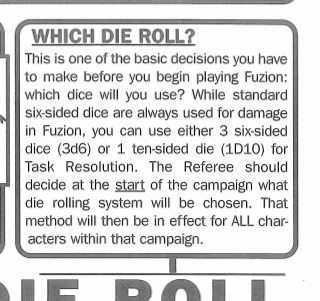
Champions used 3d6. Interlock used a d10. The devs argued and argued and argued over which type the game should be balanced around, then gave the fuck up. Does that fill you with confidence, readers?
So there's this sort of... highly elaborate mishing and mashing of various elements of two very different systems such that neither comes out the better for wear. Here's R.Talsorian's Lifepath, a character-backstory generator where you roll dice to build a character (setting-agnostic, because they were trying to sell a universal system); then here's Champions's Perks and Complications, bought using those same precious campaign points you're using to buy civilian gear (but aren't your players playing as Knight Sabers? Who needs real shit to be marked when you're building hardsuits with separate points entirely?), and complications must be activated x amount of times a session even if it diverts from the fun of playing the game. And so on and so forth. Shit, even crossing Cyberpunk with Mekton doesn't always work, since blocks of damage from Mekton (Kills) scale unsteadily with the more dice-driven combat of CP. Worse still is that the mecha system and the hacking system are off in MZ+ and CP2020 respectively, so if you want to custom-build hardsuits beyond the small pool of tools you're given on the last fucking page of the book, or you want your Nene equivalent to do something useful, nyah-nyah, go buy more books.
And then I'm sure Shawn Hagen has plenty of reasons why the combat doesn't work, but we're not paying attention to him. Whatever. Let's talk about what does work, which is a mix of worldbuilding lore, stuff the R.Tal writers seemed to just sort of come up with, and a great gallery across all three books of Fucking Cool Mecha (especially BGC EX).
LORE IS SERIOUS BUSINESS FOLKS
I mean that earnestly. It's hard to get right, especially when said lore reflects upon the tone of the actual content, the plot, the franchise, whatever. But when telling stories with a licensed game, some degree of lore is, to my mind at least, incredibly mandatory. Maybe not so much for games where the story ought to be made up as one goes along (see RPG's like The Sprawl), but in the case of BGCrisis, an anime which at the time had a pretty loyal fanbase chomping at the bit for answers for their questions about the wider universe the Sabers operated in, R.TAL had to do a mix of cribbing from untranslated material, the B-Club special and all that, and making their own shit up without looking like they'd cribbed from their own work (CP2020) overmuch. The result is very uneven, but charmingly so. I almost want to say it feels more grounded than CP2020 or Shadowrun, but is that just because it's comparatively light on the ground? Perhaps. The mandatory universe timeline is one page, and focuses more on putting years to events that were already canon instead of adding extraneous stuff in.
Likewise with what the politics look like worldwide. We get a few paragraphs about how the U.S. is recovering (not collapsed as in CP2020), Japan is doing pretty good for itself as GENOM's puppet-state, Russia successfully integrated into the EU even if Eastern Europe didn't (See? Wacky shit like that can only be called charming), and China's one big North Korea (which I think is a holdover from the CP2020 Pacific Rim Sourcebook, where Deng was assassinated by Maoist radicals.) We get another dry bit about the idea of a zaibatsu lifted straight from CP2020's Corpbook 1, where Arasaka is discussed... newspapers are now faxed (look it was in BGC OVA 1 what do you want me to tell you)... on and on it goes.
I suppose I like the lore independent of the actual characters because of a few clever predictions. One is using all the cybernetics-gone-bad in AD Police Files to explain why nobody has them in the 2032 OVA, a link I sense wasn't really made concrete until this RPG. It's one of the most interesting interpretations of the source material and of cyberpunk tropes I've seen, you know, where all the splicing and dicing of the body turns out to be a fad and a failure, leaving those who bought into the trend left with butchered and failing bodies - in light of the crypto crash that seems to be dragging the stock market down back into recession / stagflation, that seems pretty classic capitalism.
The other is tied to Before And After, covering the impact of the cheap and now even more ubiquitous Boomers of Crash:
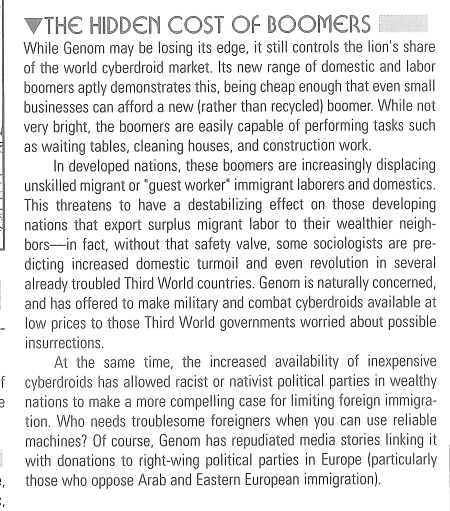
I mean, what can I say? I like predictions of the future that actually consider the effects of hyper-futuristic technology in that sort of way.
That's what a lot of the RPG's lore is at its best, basically working overtime to paper in the gaps left ignored by the series' creators. So we get a nuanced look into how ADAMA is different than similarly-sentient Boomers from the ADPF OVA; we get the Largo = Mason + Boomer Messiah explanation theory that the internet came up with just a year or two prior to the RPG's publishing; we get conspiracy theory proposals about whether or not GENOM undermined the cybernetics market to replace the enhanced with Boomers; we get to see the ADP go from hotshot riot suppression force able to slaughter undesirables en masse to actively disdained by GENOM; a weird consideration of how recognizing Boomer rights could still serve GENOM's agenda... on and on and on. It's such a mishmash of ideas, beautiful because of it.
Obviously no sane RPG player would ever give a rat's ass about any of this, but again, this was a product also marketed towards fans who just wanted a good worldbuilding book. I'm not saying you should take every part of the RPG's world into your own fanfiction, but you can take a great deal of it in and things will hold up.
POWER CREEP? YEAH, I'VE GOT THE POWER, CREEP!
The actual sourcebook sections of the sourcebooks are a) the characters, and b) the mecha. That's it, that's all. Civilian gear is almost an afterthought shoved into the front of the book like it didn't need to be there, cybernetics don't show up until Before and After. For although there is a section in the corebook proposing non-Saber campaigns players can run, they're essentially permutations of the already-existing types from CP2020: Corporates, mercenaries, medias, etc. And why, I ask you, would you run anything else but your own fanmade Saber team in your home city, overgrown and under threat? Shit, RTAL even went out of their way to put a few pages in EX, the last book in the series, highlighting player campaigns with online presences (Geocities, email addresses, etc.) and describing them in brief. Oh, to be a fly on the wall for the play sessions of the guys who did Mega-Gotham...
Anyway, back on topic. Both character pages and mecha pages get a great deal of settei transposed onto these pages, concept art ripped straight from Artmic's design docs and provided, again, more as a nerd resource than anything super useful. This especially comes into play in BGC: EX, where all the concept art and mecha are instead from everything that wasn't animated. Rejected concepts for hardsuits with wheels for feet; Boomer sketches only found in old hobby magazines; scribbles one of the Crash! mecha designers tried to get in that were apparently labeled 'problematic' (I guess he was a toy designer before all this?). I unironically love all this shit, even the beam cannons mounted on a hardsuit right where the boobplates are. Shit, my Discord profile pic is a non-Boomer mecha supposedly used by the JSDF, a 'Battlemover' whose origin I have no idea about, but which looks cool as hell. That's the kind of weirdo fan I am.
My point is that if you need to spice up your fiction, throwing 'new Boomer X' at the Sabers is one thing, giving the Sabers some power-up parts you dreamed up is another, but using the designs Artmic came up with before you did is more galaxy-brained than either. Shit, I should know, it was what Craig Reed did for the fanfics that I continued off of back in the day. And it's the same with these extraneous lore details that some rando RTAL staffer dreamed up a quarter-century ago, because they beg to have an entire fanfic made about any one of them. What happened to Jeena, folks? Inquiring minds want to know.
Anyway, that's it. That's all. Read through these and be a better fan because of it.
4 notes
·
View notes
Text
Steven Universe: End of an Era: Outline & Review
I wrote this review in October but never got around to posting it here
Steven Universe: End of an Era is far more than an art book–it’s also a collection of behind-the-scenes material, stories about the experience of working on the show, planning documents and associated background info, and both older versions of developed concepts AND concepts that never made it into the show. It's a huge fusion of all those elements, and it's definitely an experience!
Some low-quality images are included with my review just to give you an idea of what’s there--it’s not a good substitute for getting your own copy, but here’s a tour!

Like the previous concept art book, Art and Origins, I'll be giving you a description of the structure and overview, while also collecting notable information for fans. Obviously just about everything is "notable" once again, but I'll aim for unique insight or perspective on the main source material, keeping the screaming about everything new to a minimum so you can also enjoy something for yourself if you pick it up. My low-quality photos should prevent people from feeling like I'm reproducing the book in any capacity. Please grab one while you can and have your own experience!
[SU Book and Comic Reviews]
OVERVIEW
The book is titled "End of an Era" for a couple reasons--obviously because it is released after the show has wrapped, but also because Gem history recently ended its "Era 2" and began Era 3--an age of prosperity and peace. The author--the person in charge of adapting all of this information into this slick, readable package--is Chris McDonnell, whose work was previously applied on the Art and Origins book.
The foreword is by N.K. Jemisin, a well-known science fiction author who's a huge fan of the show (and wrote a really excellent series that also has a weird geological connection, by the way).
And the cover, like its predecessor, is shiny and decorated with a beach scene featuring minimalistic characters--this time it's the Gems at night in front of the Temple, and on the back cover is a big pink leg ship in a cross-legged pose.
The interior covers are decorated with tons of amazing sketches of Steven and Connie on the front, and a bunch of Gem sketches on the back. Every interior page that most would leave blank is highlighted with some kind of sketch art or character exercise--it's so much to look at, so much to absorb.
The book is dedicated "For Eddie."
Its organization is different from the previous book in that it shares applicable work in chunks associated with groups of episodes rather than pertaining to different aspects of building the show.
FOREWORD

N.K. Jemisin gives us such a great introduction to the book--apparently understanding very well that the audience of this book is full of animation enthusiasts and adult fans more than it is full of kids, and explaining that bewildering journey some adults had from blowing this show off as a silly kid thing to falling in love with it hard and fast.
The important thing, Jemisin says, is being able to trust a storyteller with your heart. And it was clear to her that Rebecca Sugar knew what she was talking about and was saying important things about identity and the radical power that comes with accepting it and demanding respect.
Important also is how we handle heroes and who gets to be one in fantasy. That's part of the reason Steven Universe speaks to so many--because we see ourselves here, and know stories can be about us. Acknowledging the power we all have to MAKE THINGS BETTER with what we fight for is so important--especially if we're going to speaking to the next generation about it.
Highlighting Rose Quartz as a "born leader" who failed and Steven as a relatable scamp who did what she couldn't, Jemisin asserts that we can save the world.
1. END OF AN ERA
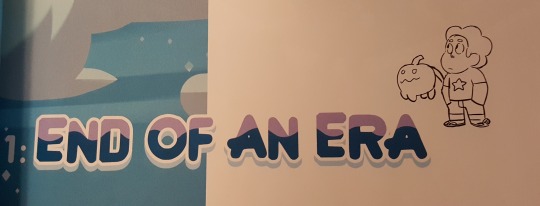
We start with an appeal to the audience to think about identity and the formative parts of our childhood--and how different it is if who you are and who you become is restricted, mocked, erased, or Not Allowed. Most people, if not ALL people, can relate to this, but for those of us with a special relationship with Steven Universe because of queer identity, this hits hard.
But it doesn't have to be anything grand to be something we respect--this show's authenticity comes largely from how personal everything is, drawn from real-life experiences and incidental truths from each artist's perspective, leaning hard on childhood and formative experiences.
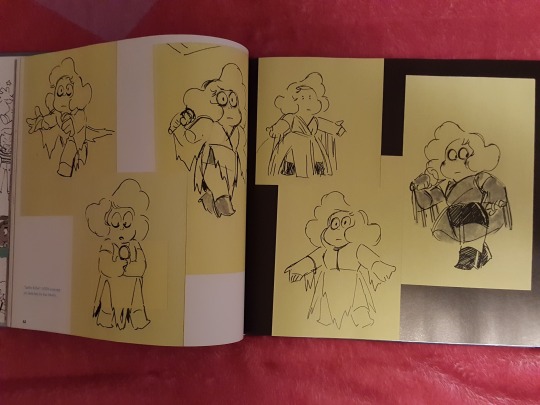
Rebecca Sugar offers some interview bits to discuss writing philosophy and why "writing female characters" was difficult for a nonbinary person who'd been socialized as a girl and a woman. Rebecca has spoken before about how frustrating it is that marketing for cartoons was SO gendered when she was growing up (and to some extent still is).
The Gems in the story are all "she/her," but on their planet they're defined by their work, not by emotion or relationships (unlike women in our society), so having them be socialized opposite to how she was and be able to claim those emotions through choice and NOT as just an expectation "as women" was revolutionary. Rebecca wants her show to tell all marginalized people that they don't deserve to be in the margins.
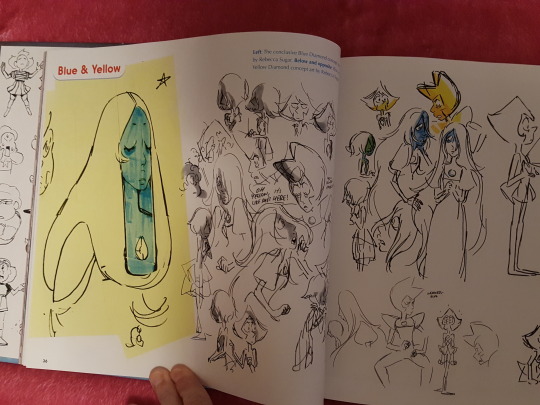
Weighing in on other aspects of the show were Ian Jones-Quartey, Joe Johnston, and Miki Brewster. Ian describes feeling like at first doing SU was a thrill ride that meant they'd finally get to do all the cool stuff, but it quickly became a responsibility that he took very seriously--the need to tell a good story now that he'd been given a megaphone.
Promotional art, planning documents, character sketches, and concept art from the lighthearted to the stone serious is included, along with some very cool (sort of famous) timeline charts that track major characters' developments. It's emphasized by Rebecca that the developmental materials ARE NOT CANON (and especially are not MORE canon) compared the final show.
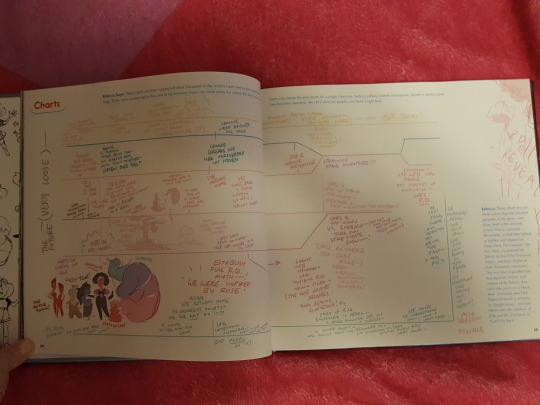
There are concept sketches alongside final art for Aquamarine and Topaz in "Wanted" (with Topaz labeled "Imperial Topaz"), the Zircons in "The Trial," Blue and Yellow Diamond, and the Off Colors (including Pink Lars).
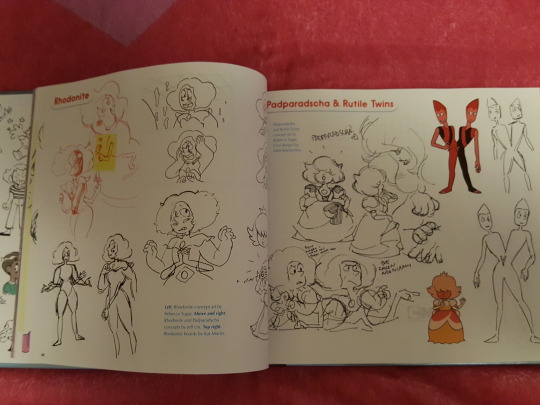
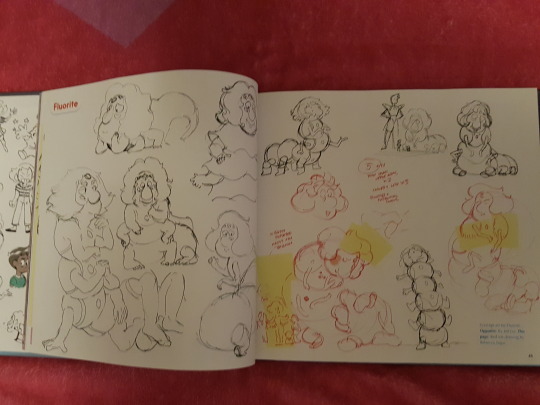
And there's also a spread of "the two sides of Steven's life: Gem Magic and Rock N Roll" featuring Sadie Killer and the Suspects (referred to as "Buck's band")--as well as a cool "Crew Cameos" key and some concepts for short-haired Connie.
And then there's some more "finished" art with stills alongside concepts, including some background art, revision, and really cool "fairytale" art from some of the shadowplay storytelling bits. We get "Lars of the Stars," "Jungle Moon," and "Can't Go Back."
2. THE BEGINNING OF THE END: A SINGLE PALE ROSE

In discussing the huge reveals and Gem mysteries in the show, the pacing is examined, and emphasis is put on the intended "slow burn." One of the most difficult things in the show was to strategize so that every piece that was needed to support another piece in the future was placed properly to seed what it was supposed to.
Some of the ideas they developed were more of a group effort and were fit together collaboratively (like Amethyst's being younger than the other Gems and Jasper being from Earth), while others were intended from the beginning based on Rebecca's vision (the fundamental idea of Pink Diamond's true identity, for instance, as well as Obsidian's design and sword and our Pearl not being Pink's first).
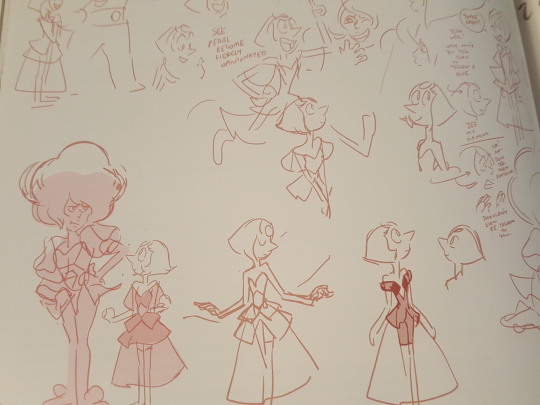
The writing process gets a great deep dive here, including fun tidbits like how the orb in the moon base was inserted by Joe Johnston and they literally had no idea what it was for when they wrote the episode. They repurposed it when they figured out what they needed.
Rebecca credits her detailed timelines for helping keep the order straight, and discusses how other artists are sometimes flabbergasted that a storyboard-driven show can have this much detail and continuity and yet not get wrecked by the free non-scripted boarding process. But Rebecca and the Crew valued that approach and loved the way fresh eyes would handle an idea, making it come back alive, entertaining, vivid.
Several Crew members weigh in on the writing process. Lauren Hecht refers to making lots of incorrect guesses despite being on the inside. Joe Johnston recalled getting briefed on his first day and getting so excited to start working on this massive project.
Miki Brewster remembered being told Rose Quartz is Pink Diamond and being shocked--and also confused about why Ruby and Sapphire would need to be married if they're already basically married. Drew Green talks about being brought in late and getting to watch unaired episodes and a rough of the movie while eating cereal.
Ian Jones-Quartey complains about Pink Diamond's real jester-like form being leaked to the internet through a Hot Topic shirt. Rebecca piggybacks on that and says it was upsetting that the wedding was leaked because of toy fair keychains featuring Ruby and Sapphire in wedding attire. They'd always be worried about leaks, and sometimes Rebecca struggled not to talk about the reality of Pink Diamond before the reveal because she knew it would make so much more sense once the truth was out. And everything associated with Rose makes more sense once you know she's Pink--especially what happened with Bismuth, considering what we know about how Pink Diamond has a habit of treating anyone who no longer serves her interests.
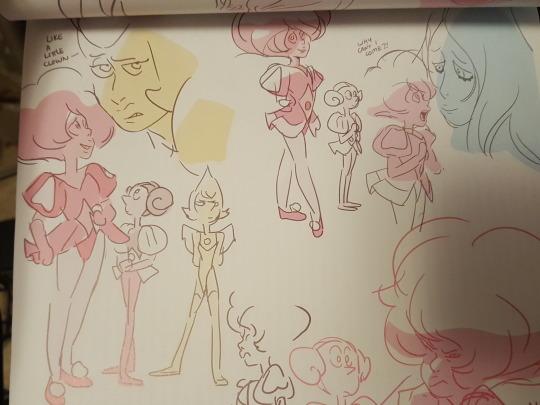
When it comes to visual cues, Rebecca also talks about intentional designs to create a feeling of unity between concepts, like the flower shapes on Pink Diamond's palanquin lining up with the poofs of Steven's hair and the star imagery of the series. Steven Sugar and Mary Nash discuss how the Human Zoo incorporated this imagery, trying to look like Homeworld with a Pink Diamond touch.
Steven Sugar, as a game nerd, liked to throw in video game references from old and modern stuff to feel like he's inserting what he's enjoying and who he is from moment to moment, while Mary Nash, who related to Sadie as a basement-dwelling young person with cult interests, liked to include stuff from MST3K and cult movies. Pearl's hand gestures get a spotlight too--her reflex to cover her mouth when Pink Diamond was being discussed was analyzed here.
A "Top Secret Visual Timeline" from 2016 is included which tells us some Diamond history. It has an earlier version of Pink Pearl's fate and does not include Spinel since the movie hadn't been greenlit. The timeline includes the birth of the Diamonds, the emergence and major story beats for each major character, and some philosophy of the driving force behind each.

We're told that Pink Diamond straightened up, behavior-wise, after she lost her first Pearl, and that Yellow and Blue wanted to give her a planet but White only agreed to it to prove she would fail at managing a colony. Pearl, meanwhile, is so confused to have a Diamond who keeps asking her what she thinks when she doesn't believe she should have opinions.
And when Pink moonlighted as Rose to start conflict, she found herself leading an army to fight Pink's troops--then Yellow's, and eventually Blue's too. Lapis is said to be waiting for the conflict to end on Earth so she can terraform, but she gets trapped instead.
Pearl's love story with Rose is described as "an endless honeymoon" where she's free to love her, while Rose's is more like "I'm now the head of the family and I'm going to give everyone what they never had, so everyone is super special!"
Jasper is described as "adopted" into Yellow's army as the only successful Beta Quartz. And White Diamond knew that Pink Diamond was not dead--she thought she was just running away from home like a brat and would eventually be back.
3. THE HEART OF THE CRYSTAL GEMS

Now we discuss Rose Quartz--the original Pink Diamond. How she was selfish and selfless, never enough and always too much, and how Greg was her first partner who "challenged her" to be an equal. Rebecca describes Rose as being delighted by the idea that both she and Greg reinvented themselves, but when that leads her to want to share her past, Greg isn't interested--he only wants to know who she is now, and doesn't consider the old her to be her.
Rebecca likes Carl Jung's concept of "enantiodromia," which is the idea that extremes lead to their extreme opposite. This is demonstrated in all of the Diamonds. This narrative is interspersed with drawings of Greg and Rose being cute.
But another "heart" of the Crystal Gems is its relationships--particularly, Garnet, the fairy tale romance embodied. More psychological theories are discussed with regard to differentiation in a relationship making the relationship stronger, and how they made sure that happened for Garnet during the appropriate arc. Rebecca has struggled with the idea that she, like Ruby, went straight from a "family" group to a living-with-others situation and never lived by herself. But she also learned that you can in fact develop as a person in the context of a relationship--you don't have to be alone to do it. Ruby learned that too, and chose on her own terms to be with Sapphire.

The wedding made so much sense to Rebecca and the crew that they couldn't imagine a wholesome couple like Ruby and Sapphire not having a wedding episode. They wanted it for years: The wedding concepts always included the tuxedo for Sapphire and the wedding dress for Ruby.

But pushback (often blamed on the conservative standards of the international market) led to negotiations trying to keep Ruby and Sapphire's relationship from being explicit. Rebecca and the Crew were very tired of this double standard, and they were especially irritated by attempts to claim a wedding wouldn't be well received by a core demographic or wouldn't make sense for Steven's character. But other shows had done weddings and Steven had been established to love weddings already.
Rebecca kept adding more elements to the wedding episode to answer all the concerns, but she didn't want to back down from explicit marriage between these characters. They deserved it. And the audience deserved to see this as wholesome, like any other cartoon wedding. Eventually they got their way and were allowed to have the wedding. But the ordered episodes were also coming to a close without promise of more, so Rebecca had to request more episodes to be able to wrap up the storyline!
And of course, there is Steven, the true heart of the team. A very interesting aside discusses Garnet's leadership and how the network pushed the Crewniverse to acknowledge Steven as the leader. This was successfully resisted throughout as well--because Garnet is the leader (unless she's incapacitated, of course). It's fantastic that this concept was preserved because too often a young male chosen one is elevated above people with more experience and knowledge because of that chosen one tradition, so it's really nice to have a show acknowledge that team leadership is more appropriate for an adult.
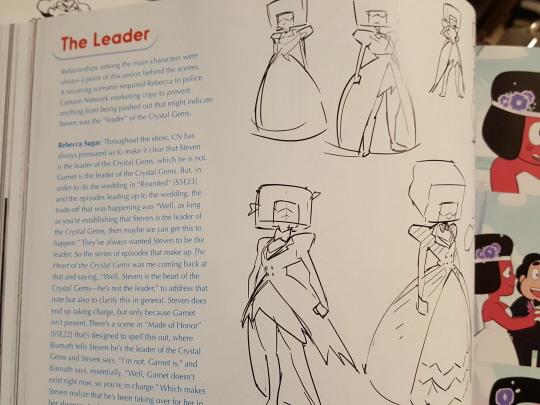
4. ERA 3

Beginning with a discussion of the Diamonds, this chapter deconstructs the dysfunctional "family" of the Diamonds (who are said to be based on tropes about evil stepmothers and stepsisters), with the thread of dysfunction originating with White Diamond.
Yellow is physical, Blue is emotional, White is judgmental, and Pink is impulsive. Some philosophy on why Pink is naturally manipulative and why she clashes so much with White is offered.
White believes her identity is to be imposed on all because she is the pinnacle of what should be--and therefore, she has the right to make decisions and statements about and on behalf of everyone. But her secret is that she can't do what the others do--act or feel or want. In trying to be everyone, she is no one.
And this becomes very important when she confronts Steven about his identity and turns out to be wrong. The triumph of Steven being totally, fully himself is a beautiful, simple revelation that's described as far more satisfying than the theories about Pink living inside him or Rose returning from his Gem.
Also discussed is Gem architecture. A lot went into this idea, and Steven Sugar weighs in to say he had to think of what it would mean for a world to have buildings but serve no human needs. That's why it's mostly focused on transport and storage. Even the broken planet is meant to indicate a place stripped for its resources, and everything serves a function that is meant to avoid looking like the human equivalents.
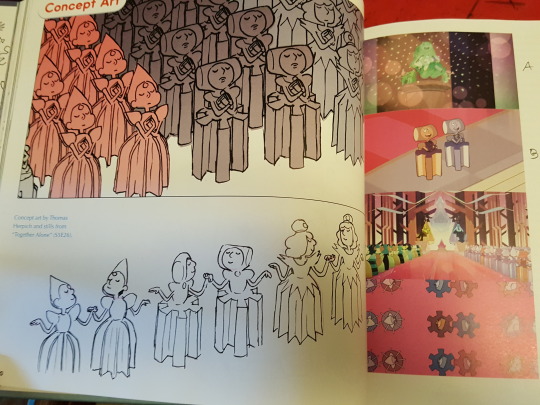
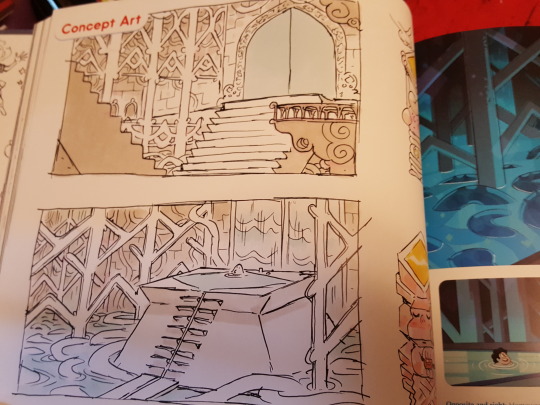
And there's another layer, too: a difference between Era 1 and Era 2. Era 2 became more functional to hide Era 1's broken bits, and older Homeworld buildings still have some "ornate and ancient" feel to them. And the fact that props, tools, and even walls and doors could be living was taken from a concept Rebecca thought was horrible from old Busby Berkeley movies, where people were inanimate objects and it was portrayed as lovely. Tom Herpich helped conceptualize these living objects.
Steven dealing with "princess tropes" is discussed here too. The Pebbles (worked on with Pendleton Ward) were sort of his Cinderella's mice, and all the locked-in-a-tower, having supportive tiny friends help you, getting princess clothes made, attending a ball, having to mind your manners stuff was intentionally related to fairy tales.
The point of doing that (besides fun) was to easily invoke the feeling that Steven was being made to be someone he's not, and that he was being treated like THIS is who he really is when it isn't. White Diamond as the "evil stepmother" is discussed with regard to her detailed features and massive scale. They generally didn't put fingernails and eyelashes on characters (especially not to indicate that they were women or girls!), but they decided White would get all of these feminine markers for tradition's sake.

Rebecca also invokes several other references that were included and describes the princess tropes as "chipping away at his integrity" setting him up for the final challenge with White.
There is again tons of concept art: Homeworld architecture, Pebbles, Diamond diagrams, background Jades and Lemon Jade Fusion, Comby, Diamond extraction chambers, and White Diamond.

5. CHANGE YOUR MIND

Now we finally begin to discuss Steven's identity. The "Perfect Steven," discussed in several interviews before this book's release, was an idea back in 2013; the "ultimate Steven," beefed up and shonen-looking, was far from perfect because OUR Steven is perfect, while this alpha hero Steven idea (used in Steven Universe Future) didn't belong being idolized in such a show.
They thought about having Steven fall apart into organic half and Gem half early in the show (during "Giant Woman" after a successful fusion and unfusion, even!), but they didn't try the concept until the last episode. They didn't want the "Pink" Steven to be portrayed as "better" even though he would be more powerful, so they decided he isn't whole without his organic self and he's just as much of a shell as the organic half. They absolutely did not want any ending that required Rose to be inside him or waiting to come back. But the debates were fierce--what DOES it mean to have Rose's Gem?
Ian Jones-Quartey brings in an anecdote about his own family to emphasize some of the immigrant themes that inspired aspects of the show. He had a brother who reinvented himself elsewhere away from family without resolving issues, and all the ramifications of that were explored in the show through Rose Quartz. (He is careful to say he doesn't think his immigrant experience is like being from another planet!) But he did say you can hurt your old family even if they were toxic or didn't know the real you, and you can hurt your new family by hiding your past. The Pizza family of course was also a more direct reference to Ian's Ghanaian family.
In talking about the new Fusions from this episode, Sunstone is largely described by Miki, who also got to board the Sunstone section. Sunstone was described as a cool 1990s character and the evolution just continued into making them a fourth-wall-breaking PSA dispenser. Obsidian is also discussed, with their sword being an early concept. Steven Sugar said they totally knew it would be forged in action. Obsidian being similar to the Temple design is of course another very early detail.

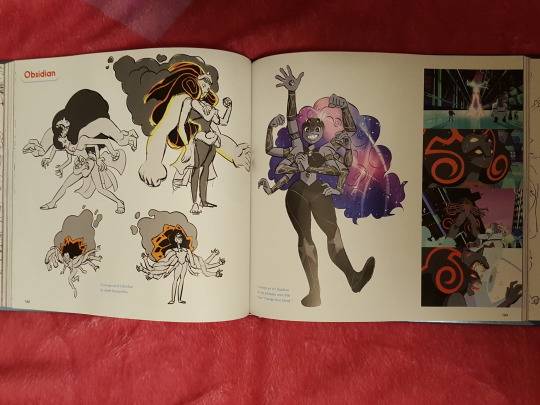
The story of how James Baxter got involved with one of the final scenes (Organic Steven and Pink Steven fusing in front of White Diamond) was shared. His family was fans of the show and Rebecca Sugar took the time to drive to a birthday party for his daughter and give her a drawing. He then owed her a favor, and this was it.

Concept art is again included, this time with sample boards, promo images, a Diamond fight concept, costume design changes for the Gems, new Fusions, the so-called "Mega Diamond" ship conglomerate, some scenes from the White Diamond confrontation, Pink Steven, multiple pages of James Baxter animation, corrupted Gems and their healed selves, and photos from the "Change Your Mind" premiere and some awards. The show has won one design-related Emmy, a Peabody Award, and a GLAAD award.
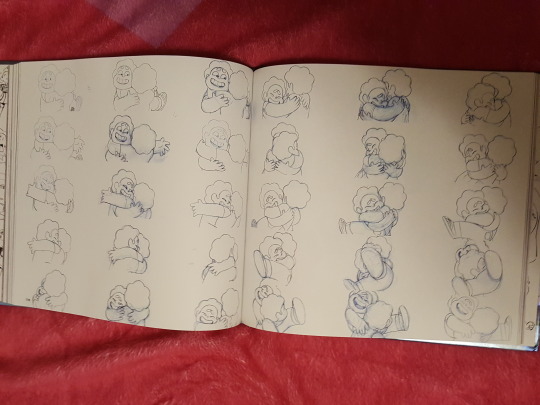
6. STEVEN UNIVERSE FUTURE
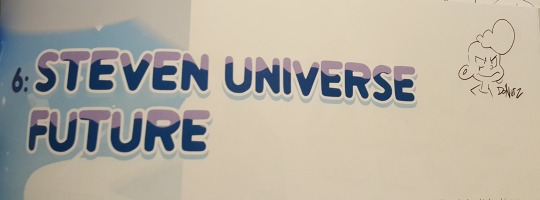
The book doesn't cover the movie because it got its own book, but dives right into Future. Ian Jones-Quartey emphasizes that the movie and Future are separate and different from the original show, which ENDED. After all, after that, Steven has a neck!
Some new names are invoked now: new writers Kate Tsang, Jack Pendarvis, and Taneka Stotts. They were excited to have Steven make HIS OWN mistakes instead of trying to clean up someone else's! Now, instead of doing the usual shonen anime thing and having the final battle be a big physical rumble, Steven has to make peace with himself and take an active role in coping with what all the fighting has done to him and what effect it's had on who he is (and who he wants to be). There is no sudden "I love myself!" answer, either. It's always a process.
Drew Green and Maya Petersen, who came on board as storyboarders officially in Future, also weighed in on writing for a "mature" show, how to deal with Steven being a "moral compass" while being sort of unreliable, and what they learned as Crew that they didn't know as fans. Drew didn't know Garnet never asks questions. Jack didn't realize the show never deviated from Steven's point of view. Taneka was nervous but excited to collaborate. Kate was worried about how established the show was and what to do as a new writer to contribute appropriately.
Maya was on the old Crew but not as a storyboarder, so felt like some of the "old" ideas ended up not being appropriate for the "new" Future in an embarrassing way--and dreaded the idea of dealing with Steven's emotional problems when they were similar to stuff she'd been through. She also was personally behind the idea of Steven wanting to dump his problems by becoming Stevonnie, and got to work with Etienne Guignard on inventing the Pearl creation backstory with Volleyball.
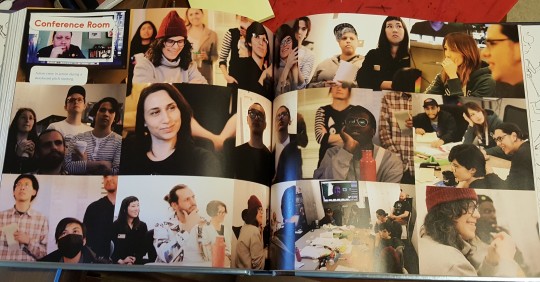
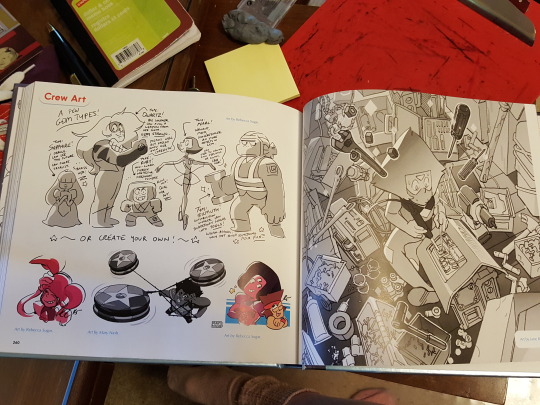
There's some discussion of "depression hobbies," stress, and the show's pacing. And they say Etienne was entertaining at pitches. There's even some discussion of how Greg is taken off a bit of a pedestal because his terrible restrictive life in the suburbs sounded wholesome to Steven and Greg presented it negatively.
And then there is some information about how the Crew felt behind the scenes due to fan reactions and negative press. Ian discusses feeling offended when the Black characters are described as bad examples, as if their cartoonized but realistic-in-context features are automatically caricatures.
Rebecca Sugar felt beaten down by some of these narratives and began to access mental health services, inspiring some of the content of "Mindful Education." A long reflection from Rebecca discusses people's infighting about her show and what she had a responsibility to show or not show in the story. She learned a lot about bullying from Cartoon Network's anti-bullying program and learned that bullies thrive on whatever attention you give them--unless it is made clear to them by a peer group that no one is impressed by their cruel actions. Also, not all negative feedback is bullying. Constructive criticism is different. Self-awareness can help you avoid internalizing what bullies might do or say to you.
Segueing from the discussion of how people are affected by and connect with the show, we then discuss how they chose as a team what should be covered as the show came to a close. They didn't have time to do quite a few stories they wanted time for, like a Rhodonite story, a Lars side story, and Diamond "prehistory" and religion; all of it was put aside for the main arc with Steven.
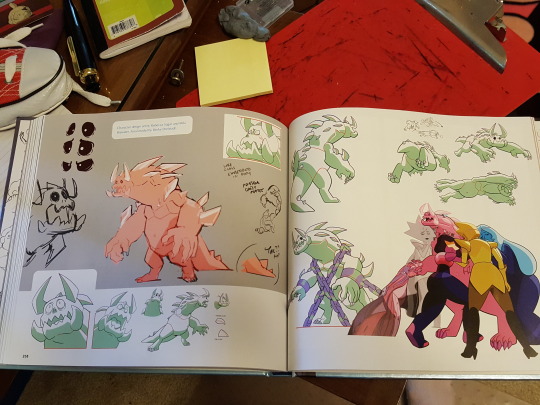
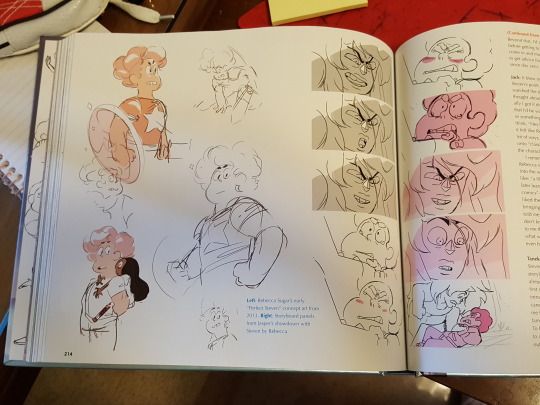
They thought people would find those stories about Homeworld and Off Color history very interesting, but so much of the show had been about Steven's Gem adventures, so keeping him mostly on Earth seemed appropriate. The acknowledgment of his battle damage, of his trauma, was necessary and real, and helpful in an important way to the core audience.
Oh, and there was some stuff about a cheeseburger tree. Don't ask.
In discussing the "reverse escapism" of the original show (Gem aliens are intrigued by everyday human culture, and realism is necessary), Rebecca says her views have changed on escapism and gets why some people want a soothing feel-better show. She acknowledged also that her own escapist dreams-come-true fulfilled in the show didn't feel like escapism because they were givens to the majority of mainstream culture, but were never guaranteed to marginalized people.
Rebecca ties in her several-times-told story about "Love Like You" and how the middle bit was when she didn't feel she was worth looking up to, and the realizations she had to tie the beginning to the end. Feeling like someone will like you less if they know you more is terrible. So sometimes a show like this can be helpful in telling people that they belong when their fantasies are things like "I want to be loved" and "I want to know I exist."
In Future, Steven has to connect to who he is and love that person--and understand that person enough to finally feel that even if he's not fixing their problems or saving their world right this second, Steven deserves his family's love and support, and they WANT to give it to him.
There's a huge amount of supplemental material in this section so there's no way I could name it all. The charts for Future's timeline are pretty straightforward, though a few episodes like "A Very Special Episode," "Why So Blue," "In Dreams," and "Bismuth Casual" aren't specifically represented and a couple are in a different order ("Prickly Pair" was conceived as happening after "Fragments" and "Homeworld Bound").
Steven feeling like a monster, having intrusive thoughts, having not forgiven the Diamonds, and getting help/moving on--it's all there.

We have keys, color scripts, and boards for the new opening and some various backgrounds and storyboard art from episodes. Model sheets for Shep, Nice Lapis and Mean Lapis, Jasper, Steven Tag Gems, Pink Steven Powers, Monster Steven. New house concepts, Era 3 Homeworld concept art for the Diamond environments, and background art for the Reef.
New Connie and Greg designs. Concepts for Mega Pearl, the Rose Quartzes, Bluebird, and Morganite (who didn't get used). And there are some photos from recording and the conference room. There are even some extras from "Crossover Nexus," the crossover with OK K.O.!--including an unused cut scene that included Ruby and Sapphire fighting. The rest of the book is a bunch of adorable Crewniverse art--extras, blog drawings, promos, and gifts to each other.
NOTABLE
1.
The first timeline chart in the book features a cool sketch of the original Off Colors, which at the time this planning document was drafted included unused Off Colors Flint and Chert.
We knew of their existence already because of an episode of the podcast, but these two unexpectedly appeared as incidental characters in the Steven Universe Future episode "Homeworld Bound," identified only in the credits. Sad to think that instead of banding with the Off Colors, these two were probably shattered for their crime (being Quartzes who don't want to fight) and that's why we see them being repaired in this episode. Later, there's some brainstorming for types of Off Colors and "a Ruby that wants to wear limb enhancers" is mentioned as well.
2.
It looks like there was also originally more juice to the story of tracking down the events of the war culminating in Pink Diamond's assassination.
One of the timelines talks about Steven thinking it makes sense that Pearl can't talk about her involvement because she might have been a double agent, explaining why Rose Quartz always knew what Pink Diamond was doing. It seems like that bit was supposed to be included in Garnet's version of the story she believed in "Your Mother and Mine." Seems like they originally conceived Garnet's story to inspire the Off Colors to become pirates and freedom fighters, though in the show's canon this storytelling happened after Lars had already reinvented himself the way he did.
Sadie was also supposed to be sending letters to Lars via Steven, which is funny since the "Letters to Lars" episode is just a montage Steven letter. And of course it's specified that Steven was supposed to get Pink Diamond flashbacks by going to the Palace on Homeworld.
3.
The second chart in the book makes references to Sadie's reinvention of herself as a parallel to Lars, Greg, and Pink Diamond all doing the same thing, and how positive it is to embrace such a thing--a version of yourself that YOU create.
I love that Yellow Diamond's arm ship arm-wrestling the Cluster was always part of the plan.
There's some more explicit direction to have Connie help Steven understand the Diamonds as "strict parents," and a lot more emphasis on everyone realizing Rose had been inspired by THEM rather than them all following her.
White Diamond is presented here as if she thinks of Pink Diamond as a "daughter" (whom she now understands she has "lost"). There are notes on how the Diamonds have a responsibility to their children and should attend to it before just continuing to make more.
4.
One of the concept art images for the Off Colors features Rhodonite crouching by Padparadscha saying "Don't worry, I won't let them hurt you." It's very interesting because she DOES seem to protect Padparadscha in the show, but doesn't seem confident about it in her final version, even though it does seem like she'd be "programmed" to guard aristocratic Gems because of her Ruby and Pearl makeup. Cool.
5.
A "Crew Cameos" spread was included, which is of great interest to some of us who loved seeing the Crew insert themselves into the show. Not every SU Crew person who's been represented in a crowd was there, but this crowd included Amish Kumar, Kat Morris, Amanda Winterstein, Angie Wang, Lamar Abrams, Emily Walus, Mary Nash, Joe Johnston, Christy Cohen, Danny Cragg, Hilary Florido, Danny Hynes, Matt Burnett, Ben Levin, Elle Michalka.
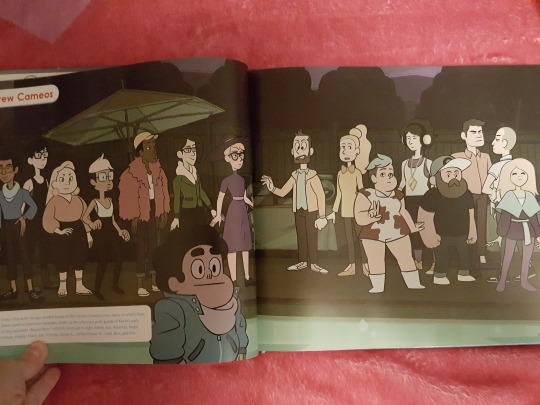
6.
The official national flower of South Korea, Hibiscus syriacus, is the name of Pink Diamond's flower.
7.
One of Steven Sugar's comments about the silhouette difference between humans and Gems points out that humans have ears. This seems to be pretty good confirmation that they are not supposed to have ears, despite that sometimes we'll see ears drawn on them in some frames.
8.
Rose Quartz/Pink Diamond is characterized in this book as "self-hating" in a really interesting way, saying that because she believed she was not capable of compassion, she practically worshiped those who demonstrated that ability and thought they were so much better than her--which is described as "intoxicating" and resulted in others being drawn to her. How interesting is that!
9.
Timelines reveal that early plans for Pink Diamond's first Pearl originally had her getting destroyed by Pink during a game, and then her destruction was rewritten as a punishment from the Diamonds after Pink Pearl defended Pink Diamond to the other Diamonds. They went back to the idea of her getting hurt by Pink for the final version, though the cracked face and control by White Diamond was not on the agenda until they started writing "Change Your Mind."
10.
The approximate ages of the major characters, based on emergence, are revealed on these timelines. It begins with a cracked-planet-looking graphic depicting four tiny Diamonds emerging at 20,000 years ago. Some suspicious "blacked out" redacting surrounds a long timeline tail that goes back before that, which may mean there are secrets they still don't want to reveal. But the dates go like this:
20,000 years ago: The Diamonds emerge.
11,000 years ago: Pearl is custom-made for Pink Diamond.
8,000 years ago: Sapphire emerges (on Homeworld).
6,000 years ago: Ruby emerges (on a colony).
5,750 years ago: Garnet is formed.
5,600 years ago: Lapis is poofed and put in the mirror.
5,200 years ago: Jasper emerges (on Earth).
5,050 years ago: The Cluster is planted.
5,000 years ago: Amethyst emerges (on Earth).
4,500 years ago: The Crystal Gems found Amethyst.
3,000 years ago: Peridot emerges (on Homeworld).
40 years ago: Pearl found Lapis's mirror at the Galaxy Warp.
And of course we know 14 years ago Steven is born!
11.
Originally the Diamonds were based on a quartet of themes: Love, Fear, Pride, and Sorrow. It got too complicated to keep and it was abandoned, with Pink's identification of "love" being described as "particularly outdated."
12.
Notes on a sketch say that Pearl was inspired to become bold and unashamed because Pink's questions drove her to have opinions, and it's said that Rose "fell in love" with her boldness.
13.
Rebecca tells the story of driving off a ridge and getting stuck in the desert, comparing this to Ruby's tumble during her Wild West adventure and using it as inspiration. She's told this story before but here it is in print. She also included the story about using the flowers from a friend's wedding to put in Ruby's hair.
14.
Rebecca describes having to "fight" notes she was given when it had to do with Ruby and Sapphire's relationship. One she describes as NOT fighting was for a signing card depicting Ruby and Sapphire dancing. It was called "too romantic" and she decided not to worry about it since it wasn't the actual show content.
She was also scolded over her book The Answer because the powers that be expected her to downplay that relationship. She always argued that queer youth deserved these things.

15.
Tom Herpich describes being inspired to name Blue Diamond's comb "Comby" because he was watching the news about Comey getting fired from the FBI. It's also a mineral-related term and I always assumed that reference was intentional, but maybe it's not and this is the only intended significance to Comby's name?
16.
Rainbow Quartz 2.0's design is not discussed, though the other two new Fusions from "Change Your Mind" (Sunstone and Obsidian) were. RQ2 has some sketches included, but no accompanying narrative in the text.
17.
A sheet of corrupted Gems and their healed selves is offered, though it doesn't appear to be final. The obelisk in "Serious Steven" is labeled Albite. The unnamed Worm Monster, Desert Glass, and Watermelon Tourmaline are included. An unnamed birdlike Gem represents the Big Bird monster from "Giant Woman." The crab monster from "Arcade Mania" is labeled Blue Chalcedony. The Tongue Monster is drawn uncorrupted but not named. The Flower Monster from "Back to the Kindergarten" is labeled Grossular Diopside or Titanite. The invisible monster from "Island Adventure" is labeled Moonstone. The Lighthouse Gem is labeled White Topaz. A form for Larimar that was used in "Change Your Mind" but changed in Future is there. The Slinker is listed as Chrysocolla. And the Crab Monster is listed as Aventurine.
On the next page, this is changed to Bixbite (as it was in Steven Universe Future), and we then also have Lace Amethyst, Blue Lace Agate, Crazy Lace Agate (Fusion), Ocean Jasper, the Mother Centipeetle Nephrite (Facet 413 Cabochon 12) and three other Nephrites, Angel Aura Quartz, a hooded Jasper, Zebra Jasper, Biggs Jasper, Watermelon Tourmaline (labeled as Fusion of Gem * Onion--huh?), Snowflake Obsidian, "Little" Larimar, and Orange Spodumene (who was the Worm).
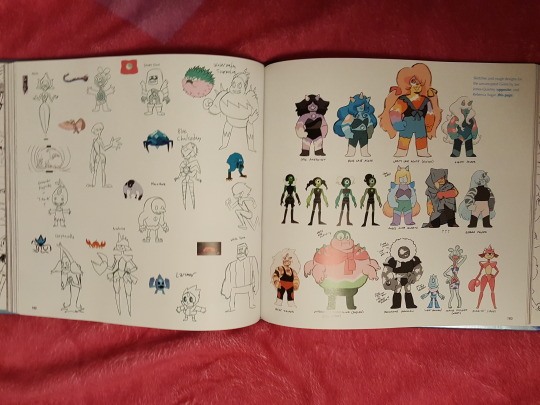
18.
The Rhodonite side story would have been about the love story of a Ruby and a Pearl working for Morganite. Images of Morganite and her servants, unfused, are in the book. We do not get this additional information, but Rebecca said in a panel shortly before the book's release that Rhodonite's story would have been about finding out that she had been Rejuvenated 17 times because her components kept falling in love and needing to be reset.
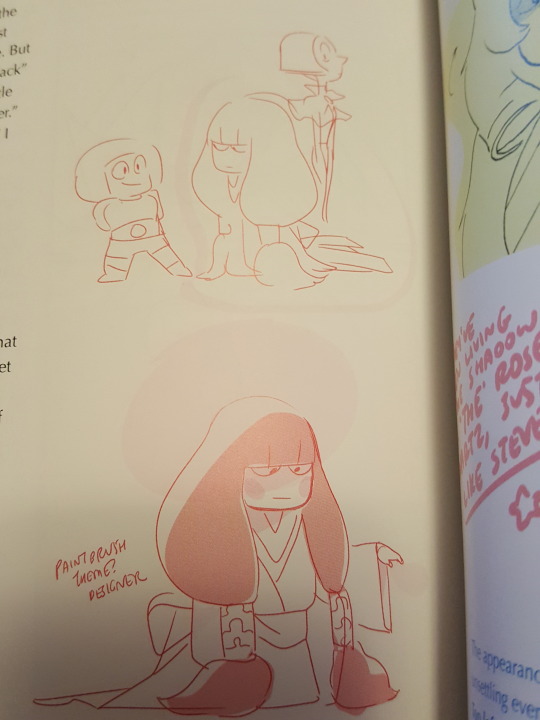
19.
Referring to the Diamonds on one of the charts, Steven's perspective is "I can't believe I helped these" and then there's a censor bar. Welp.
20.
Some included art by Hilary Florido features Kevin with a souped-up Koala Princess car and another where Kevin is staring at himself in the mirror in front of an altar to himself.
21.
Rebecca's sweater collection is included in the Crew art.
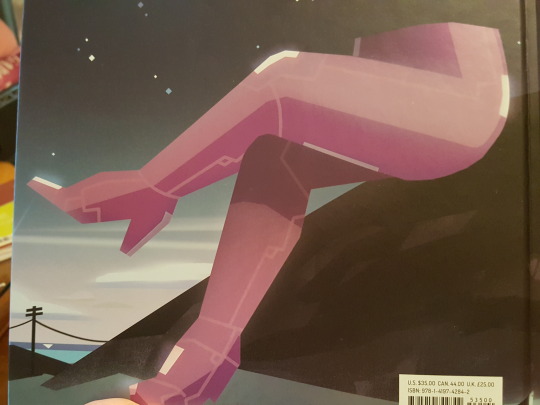
[SU Book and Comic Reviews]
167 notes
·
View notes
Note
from discord: 2, 3, 9, 19, 22
2. Is it easier to draw someone facing left or right (or forward even)
depends on if the characters asymmetrical but generally dont have problems with either + i flip my canvas to check for inconsistencies. forward is weird because depending on character design its either super easy or a nightmare (ie any characters who were never meant to be viewed facing forward)
(next one was a text doozy so making this a read more!)
3. What ideas come from when you were little
this ones gonna be weird bc i dont think i can be sure on a lot of these lmao
bio/zoology + monster stuff definitely came from childhood interest, i likea tha critters :) i wanna say my interest in bots/mechs + funky inanimate object stuff too? i did play metal slug a lot as a kid and a bunch of childhood favs were mechanical characters. also ive found fanart of putt putt, captain underpants villains, and the brave little toaster in my childhood journals lmao
oc -wise, selena herself (and vicks) also are funny in their own ways. i can say for sure they were always distinct ocs in my mind but i never actually Materialized them till very very recently. selena was based on a childhood pokemon trainer oc (but noot entirely self insert? its hard to describe) and vicks is kind of. a catharsis character for me. i have been thinking about making an entirely split oc from vicks recently bc the character i view in scenarios i want to visualize has been vicks, but i dont really wanna anymore bc she deserves to be her own deal now
...i also would argue probably the reason why mws huge cast + me just being able to. establish how they interact with each other so quickly also came from childhood ocs i never put down on paper or knew how to articulate as characters. its something im very weird about bc i straight up had a "cast" of fundamental ocs (proto-selena was one of them actually) from childhood to high school that were so personal to me i never wrote or visualized any of them bc Crinj they were just for lil ol me lmao. they liked to hang out with each other :)
finding connections between my fixation on my current characters and stuff i thought about as a kid is a thing i think about a normal amount teehee
9. What are your file name conventions
stupid and goofy but still understandable to infer what it is for personal stuff, labeled straight for work stuff. "sketchbook" files have scratchpad in the name, pieces that include characters that arent my own usually include the persons username, and annual based stuff have the year
i like to be sillay but also i am a freak about keeping my files organized lmao

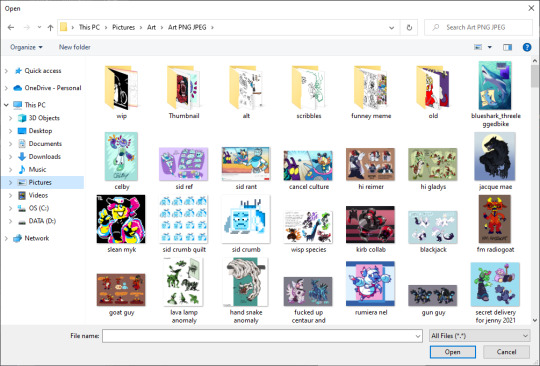
19. Favorite inanimate objects to draw (food, nature, etc.)
sid industrial machinery is really fun for me, buildings tend to be too basic and geometric for me to enjoy drawing... i wanna do more extremely stylized furniture and prop stuff (i really like those drawings that are character inventory layouts), i actually do wanna make fake object assets for my settings eventually bc i love that kind of stuff. bottles and containers are aesthetically pleasing but havent figured out rendering the sweet spot ive seen other drawings hit, at least for me
environments are something i wanna do bc those pics of super expansive landscapes with either huge structures or so open you can see the horizon stretch for miles are really cool, but still in the general learning process so itll be a while before i can even try reaching for that effect
22. What physical exercises do you do before drawing, if any
:)
i sometimes do a little wrist wriggle or crack it a bit, or ill wring my arm/shoulder, but unless my arms got a weird feeling i dont really do too much...
i squeeze both my biceps with my hands too sometime bc thats actually where i normally experience soreness from drawing
2 notes
·
View notes
Text
#showyourprocess
From planning to posting, share your process for making creative content!
To continue supporting content makers, this tag game is meant to show the entire process of making creative content: this can be for any creation.
RULES — When your work is tagged, show the process of its creation from planning to posting, then tag up to 5 people with a specific link to one of their creative works you’d like to see the process of. Use the tag #showyourprocess so we can find yours!
sabrina @lanwangiji, my love, tagged me to share my process of making this typography edit! check out her explanation of her the untamed edit and her edit tag.
1. PLANNING
i once opened lyrics edit requests so i can learn and practice typography. this edit was a request as well. i asked them which lyrics they wanted to have and the colors they’d like. since i got several requests and it was hard to keep tabs on them, i made a trello board so i could organize everything. i’m still using the trello board for every edit idea i have, the board makes my life easier.


above is what i filled the card in the board with. basically just information of the requests.
1.1 INSPIRATION
once i got the request, my first thought was to find the vibe the song/lyrics exude. “it’s an old curse” screamed witchy vibes to me, so i went to pinterest to find some inspirations. at first i was looking for witchy poster designs and i came across this. i liked how it has smoke-ish graphic and i thought the smoke suited the “old curse” lyrics. and tbh pinterest is a rabbit hole, they gave me suggestions after suggestions, like this and this which became my inspiration for the color palette (i added the gold from those pics) and the sun moon design gave me the idea to incorporate space stuffs too. i somehow landed on this too, and because i wanted to include space theme, i made a simple phases of the moon. ultimately the hero of this edit was the lyrics, i didnt want the graphics took the center stage. i was inspired to make a crystal ball and do this kind of typography but after several trials i couldnt get the the typography right, so i scratched that idea and went with the space theme instead.
1.2 PICKING COLORS
after i was feeling inspired enough, i went looking for the right colors. i usually just type “color name” and “palette” on pinterest. example “dark grey color palette” and i chose the one i liked best. when the request only asked for 1 color, i always searched for either a complimentary or contrasting color to give it a jushz, to add sprinkles. that’s why i added gold on top of the dark grey.
1.3 FINDING FONTS
this is the hardest part. the fonts play important role to the design. they need to convey the vibes of the lyrics, in this case witchy/magic vibe. i needed to find fonts or font just as magical and a bit whimsical. tho i hoard fonts... i like to use new font for every typography edit lmao sue me.
i highly recommend going to creativemarket free goods site, pixelsurplus font freebies and behance to search for fonts. i always use 100% free fonts, that means i can use it personally as well as commercially. creativemarket gives me desktop license for the fonts, which means i can use it for commercial as well. the reason i do this because i want to open an etsy shop someday, and i want to have the right license when i sell my stuffs. i almost never buy fonts bc they are expensive lmao.
the fonts in used are “Vintage” for the main typograpy (i think i was a freebie from creativemarket) and “Morganite” for the title of the lyrics and the name of artist.
2. CREATING
once i have my materials and ideas, i open my illustrator and hope it doesnt crash every 5 min.
for this kind of typography edits, i use 600x700 px. tbh i dont like using 540px, the suggested tumblr size, as the width bc to me it doesn’t look as good in quality, so i up the px. but more on this sizing later. i utilize the artboards function in illustrator, and i use 2 artboards.
i use illustrator (ai) bc i’m working with vectors. when i work with vectors, the graphics/texts or whatever im making in ai wont become blurry or lose its quality when i enlarge or shrink it. in compare to photoshop, i need to make for example the moon graphic very big, so i wont lose the quality when i reduce and enlarge it again. with vector, i can start small and when i expand it, it’s still as good as when it’s tiny.
2.1 GRADIENTS
i started with the gradients first. i created a rectangle as big as 600x700px and with the “freeform gradient” tool in ai, i played with the colors. below is the color palettes i used
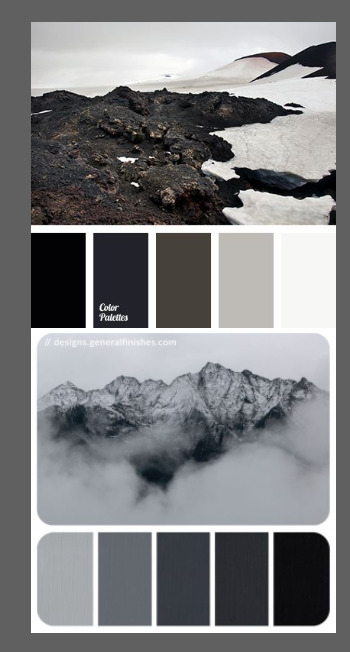
2.2 LYRICS AND GRAPHICS
once the gradients are done, i worked with the lyrics and graphics right away. when i first doing this edits, i made typos a lot lmaooooooo. so i copy and pasted the lyrics on top of my artboard, so i wouldnt have any typos.
i had 3 layers in my ai. one for the inspo pics and the OG lyrics. the rest for the edits themselves. i broke up “It's an old curse/dreamers diving headfirst” into to parts, hence the 2 more layers
i almost always started with the lyrics first then the graphics. but for this edit, i made the smoke first so i can layout where my text would be.
tbh the process of making the lyrics is a trial and error. i tried bunch of different stuffs and i chose whatever the best. but i worked like methodically, i made sure i finished the first part of the lyrics first then i could move on.
i was lucky with this font “vintage”. the font offers me several glyphs like these
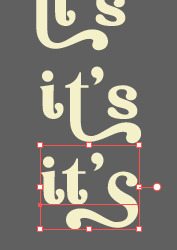
and i chose the one at the bottom. you’re very lucky if you find a font and they have glyphs.
excursion: glyphs vs fonts
glyph is an individual character. It might be a letter, an accented letter, a ligature, a punctuation mark, a dingbat, etc.
A font is a digital file which is used to display a typeface, which contains the entire upper- and lowercase alphabet as well as punctuation, numbers, and other special characters.
after i was finished with all the lyrics i added some graphics to make the edit pretty like small stars or dots. i added the song title and the artist too, sometimes at the bottom sometimes at the top. and i added my watermark put it as small as i could and made it a bit invisible but still can be seen.
2.3 EXPORTING
exporting! this is where i’m going to go deeper with the dimension of my work. in ai, i always choose to save with “export as screens” function. it automatically divides the artboards i have and save them separately. i always save as png, bc the size is smaller than jpg but can maintain the quality.
now the export tab looks like this
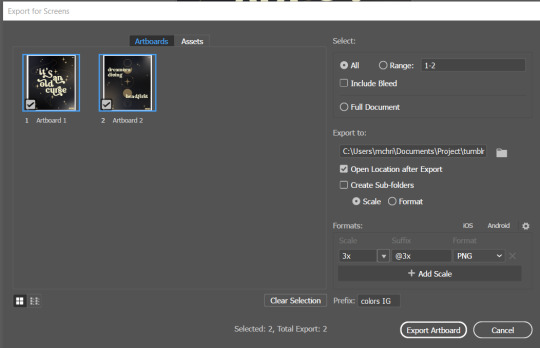
see the formats? i always scale up my edits, 2-3 times the original artboard size. reason is, to maintain the quality. i have tried to save it as original, 600x700 px, but it turned out a bit blurry. bc everything in ai is vector, when i scale up it doesnt lose the quality. BUT once i save it as png, it’s not a vector anymore, and when you zoom in until a certain degree it’ll be pixelated. that’s why i always scale up, to avoid it becoming pixelated when it’s just zoomed 1 or 2 times.
2.4 FINAL TOUCH
i opened my photoshop and also pray it won’t crash. import the png of my edits, add some grains/noise. the reason i use photoshop is, the noise filter is way better than in ai. it’s smoother somehow. and then i export my edits.
(i have a timelapse of how i made one of my edits, it’s not this one, but it’ll give you a better visualization. find it HERE
3. POSTING
now the hardest parts are done, we go to posting!
i uploaded the 2 posters on tumblr as photos then i wrote the captions. for this typography edit, i always chose another lyrics that i like from the same song for the caption. i bolded the lyrics, add link to all of my typography gradient edits.
i always use this link to color my caption. i usually choose 3-4 colors, and i took the colors from my edit. but this was not until recently lmao. before i just took a guess and looked for similar colors that match the edit, but then i thought “why didnt i just use the color in the posters lmao”
ok after i have my html code for the caption, i go to this site to replace the “;” with “ “ so tumblr can read the code.
i’m not one who puts their edits in draft, bc i just cant wait to post it. i have to option here, either i post it immediately when the time is right (i usually post between 4-8) or i schedule it, if im finished before 4.
i put all the necessary tags and click post! i am done finally!
i’m tagging:
@thetriangletattoo for this amazing series
@deludedandlostcause for this impressive gif
@half-lightl for this spectacular edit
@gayndrew for this stunning drawing
@thechampagnelovers for this cool collage
@cloudslou for this incredible edit
@heyangels for this incredible edit
35 notes
·
View notes
Text
hmmmmmmmmmm maybe i’ll write an Introspective Musing Post about my relationship to religion and their depiction in stories because i’ve pondering about this topic lately
so for those who are reading this and DON’T know what’s been going on... there’s this webcomic i fell in love with some years ago, about six years actually, that depicts a post-apocalyptic fantasy/horror adventure set in the nordic countries. it had, and has still, some very uncomfortable flaws regarding racial representation, and the creator has historically not dealt very well with criticism towards it. it’s a whole Thing. my relationship with this comic has fluctuated a lot, since there are a lot of elements in it i DO love and i still feel very nostalgic about, and like idk i felt like i trust my skills in critical thinking enough to keep reading. aaand then the creator went a teensy bit off the deep end created a whole minicomic which is like... a lukewarm social media dystopia where christians are oppressed (and also everyone is a cute bunny, including our lord and saviour jesus christ). which is already tonedeaf enough considering there are religious people who DO get prosecuted for their faith, like, that’s an actual reality for a lot of people - but as far as i can tell, usually not christians. and then there’s an afterword that’s like, “anyway i got recently converted and realized i’m a disgusting human being full of sin who doesn’t deserve redemption but jesus loves me so i’ll be fine!! remember to repent for your sins xoxo” and a bunch of other stuff and IT’S KIND OF REALLY CONCERNING i have, uh, been habitually looking at the reactions to and discussions around this, maybe it’s not very self care of me but there’s a lot of overwhelming things rn and it’s fantastically distracting, yknow? like, overall this situation is fairly reminiscent of the whole jkr thing. creator of a series that is Fairly Beloved, does something hurtful, handles backlash in a weird way, a lot of people start taking distance from Beloved Series or find ways to enjoy it on their own terms, creator later reveals to have been fully radicalized and releases a whole manifesto, and any and all criticism gets framed as harassment and proving them right. of course, one of them is a super rich person with a LOT of media power and a topic that is a lot more destructive in our current zeitgeist, and the other is an independent webcomic creator, so it’s not the same situation. just similar vibez ya feel as a result of this, i have been Thinking. and just this feels like some sort of defeat like god dammit she got me i AM thinking about the topic she wrote about!!! i should dismiss the whole thing!!! but thinking about topics is probably a good thing so hey lets go. me, i’m agnostic. i understand that this is a ‘lazy’ position to take, but it’s what works for me. i simply do not vibe with organized religion, personally. (i had the wikipedia page for ‘chaos magic’ open in a tab for several weeks, if that helps.) i was raised by atheists in a majorly atheist culture. christian atheist, i should specify. norway has been mostly and historically lutheran, and religion has usually been a private and personal thing. it turns out the teacher i had in 7th grade was mormon, but i ONLY found out because he showed up in a tv series discussing religious groups in norway later, and he was honestly one of the best teachers i have ever had - he reignited the whole class’ interest in science, math, and dungeons and dragons. it was a real “wait WHAT” moment for my teenage self. i think i was briefly converted to christianity by my friend when i was like 7, who grew up in a christian family (i visited them a couple times and always forgot they do prayers before dinner. oops!), but like, she ALSO made me believe she was the guardian of a secret magic orb that controls the entire world and if i told anybody the world would burn down in 3 seconds. i only suspected something was off when one day the Orb ran on batteries, and another day the Orb had to be plugged in to charge. in my defense i really wanted to be part of a cool fantasy plot. i had no idea how to be a christian beyond “uuuuh believe in god i guess” so it just faded away on its own. when i met this friend several years later, she was no longer christian. i think every childhood friend of mine who grew up in a christian family, was no longer christian when they grew up. most notably my closest internet friend whose family was catholic - she had several siblings, and each of them took a wildly different path, from hippie treehugger to laveyan satanist or something in that area. (i joined them for a sermon in a church when they visited my town. my phone went off during it because i had forgotten to silence it. oops!) ((i also really liked their mother’s interpretation of purgatory. she explained it as a bath, not fire. i like that.)) i have never had any personal negative experiences with christianity, despite being openly queer/gay/trans. the only time someone has directly told me i’m going to hell was some guy who saw me wearing a hoodie on norway’s constitution day. yeah i still remember that you bastard i’ve sworn to be spiteful about it till the day i die!! i’ve actually had much more insufferable interactions with the obnoxious kind of atheists - like yes yes i agree with you on a lot but that doesn’t diminish your ability to be an absolute hypocrite, it turns out? i remember going to see the movie ‘noah’ with a friend who had recently discovered reddit atheism and it was just really exhausting to discuss it with her. one of these Obnoxious Atheists is my Own Mother. which is a little strange, honestly, because she LOVES visiting churches for the Aesthetic and Architecture. we cannot go anywhere without having to stop by a pretty church to Admire and Explore. I’VE BEEN IN SO MANY CHURCHES FOR AN ATHEIST RAISED NON-CHRISTIAN. i’ve been to the vatican TWICE (i genuinely don’t even know how much of my extended family is christian. up north in the tiny village i come from, i believe my uncle is the churchkeeper, and it’s the only building in the area that did not get burnt down by the the nazis during ww2 - mostly because soldiers needed a place to sleep. still don’t know whether or not said uncle believes or not, because hey, it’s Personal) i think my biggest personal relationship to religion, and christianity specifically, has been academic. yeah, we learned a brief synopsis of world religions at school (and i remember the class used to be called ‘christianity, religion, and ethics’ and got changed to ‘religion, beliefs, and ethics’ which is cool. it was probably a big discourse but i was a teen who didnt care), but also my bachelor degree is in art history, specifically western art history because it’s a vast sprawling topic and they had to distill it as best they could SIGHS. western art history is deeply entangled with the history of the church, and i think the most i’ve ever learnt about christianity is through these classes (one of my professors wrote an article about how jesus can be interpreted as queer which i Deeply Appreciate). i also specifically tried to diversify my academic input by picking classes such as ‘depiction of muslims and jewish people in western medieval art’ and ‘art and religion’ when i was an exchange student in canada, along with 101 classes in anthropology and archaeology. because i think human diversity and culture is very cool and i want to absorb that knowledge as best as i can. i think my exchange semester in canada was the most religiously diverse space have ever been in, to be honest. now as an adult i have more christian friends again, but friends who chose it for themselves, and who practice in ways that sound good and healthy, like a place of solace and community for them. the vast majority of my friends are queer too, yknow?? i’ve known too many people who have seen these identities as fated opposites, but they aren’t, they’re just parts of who people are. it’s like... i genuinely love people having their faiths and beliefs so much. i love people finding that space where they belong and feel safe in. i love people having communities and heritages and connections. i deeply respect and admire opening up that space for faith within any other communities, like... if i’m going to listen to a podcast about scepticism and cults, i am not going to listen to it if it’s just an excuse to bash religion. i think the search for truth needs to be compassionate, always. you can acknowledge that crystals are cool and make people happy AND that multi level marketing schemes are deeply harmful and prey on people in vulnerable situaitons. YOU KNOW???? so now’s when i bring up Apocalypse Comic again. one of the things i really did like about it was, ironically, how it handled religion. in its setting, people have returned to old gods, and their magic drew power from their religion. characters from different regions had different beliefs and sources. in the first arc, they meet the spirit of a lutheran pastor, who ends up helping them with her powers. it was treated as, in the creators own words, ‘just another mythology’. and honestly? i love that. it was one of the nicest depictions i’ve seen of christianity in fiction, and as something that could coexist with other faiths. I Vibe With That. and then, uh, then... bunny dystopia comic. it just... it just straight up tells you christianity is literally the only way to..?? be a good person??? i guess?? i’m still kind of struggling to parse what exactly it wanted to say. the evil social media overlord bird tells you the bible makes you a DANGEROUS FREETHINKER, but the comic also treats rewriting the bible or finding your own way to faith as something,, Bad. The Bible Must Remain Unsullied. Never Criticize The Bible. also, doing good things just for social media clout is bad and selfish. you should do good things so you don’t burn in hell instead. is that the message? it reads a lot like the comic creator already had the idea for the comic, but only got the urge to make it after she was converted and needed to spread the good word. you do you i guess!! i understand that she’s new to this and probably Going Through Something, and this is just a step on her journey. but the absolute self-loathing she described in her afterword... it does not sound good. i’m just some agnostic kid so what do i know, but i do not think that kind of self-flagellating is a kind faith to have for yourself. i might not ever have been properly religious, but you know what i AM familiar with? a brain wired for ocd and intrusive thoughts. for a lot of my life i’ve struggled with my own kind of purity complex. i’ve had this really strange sensitivity for things that felt ‘tainted’. i’ve experienced having to remove more and more words from my vocabulary because they were Bad and i did not want to sully my sentences. it stacked, too - if a word turned out to be an euphemism for something, i could never feel comfortable saying it again. i still struggle a bit with these things, but i have confronted these things within myself. i’ve had to make myself comfortable with imperfection and ‘tainted’ things and accept that these are just, arbitrary categories my mind made up. maybe that’s the reason i can’t do organized religion even if i found one that fit for me - just like diets can trigger disordered eating, i think it would carve some bad brainpaths for me. so yeah i’m worried i guess! i’m worried when people think it’s so good that she finally found the correct faith even if it’s causing all this self-hate. is there really not a better way? or are they just trusting she’ll find it? and yeah it’s none of my concern, it’s like, i worry for jkr too but i do not want her within miles of my trans self thANKS. so like, i DO enjoy media that explores faith and what it means for you. my favourite band is the oh hellos, which DOES draw on faith and the songwriter’s experience with it. because of my religious iliteracy most of it has flown over my head for years and i’m like “oh hey this is gay” and then only later realize it was about god all along Probably. i like what they’ve done with the place. also, stormlight archive - i had NO idea sanderson was mormon, the way he writes his characters, many of whom actively discuss religion and their relationship to it. i love that about the books, honestly. Media That Explores Religion In A Complex And Compassionate Way... we like that i’ve been thinking about my own stories too, and how i might want to explore faith in them. most of my settings are based on magic and it’s like, what role does religion have in a world where gods are real and makes u magic. in sparrow spellcaster’s story, xe creates? summons? an old god - brings them to life out of the idea of them. it’s a story about hubris, mostly. then there’s iphimery, the story where i am actively fleshing out a pantheon. there’s no doubt the gods are real in the fantasy version of iphimery, they are the source of magic and sustain themselves on slivers of humanity in exchange. but in the modern version, where they are mostly forgotten? that’s some room for me to explore, i think. especially the character of timian, who comes from a smaller town and moves to a large and diverse city. in the fantasy story, the guardian deity chooses his sister as a vessel. in the modern setting, that does not happen, and i don’t yet know what does, but i really want timian to be someone who struggles with his identity - his faith, his sexuality, the expectations cast upon him by his hometown... i’m sure it’s a cliché story retold through a million gay characters but i want to do it too okay. i want to see him carve out his own way of existing within the world because i care him and want to see him thrive!!! alrighty i THINK that’s all i wanted to write. thanks if you read all of this, and if you didn’t that’s super cool have a nice day !
32 notes
·
View notes
Photo
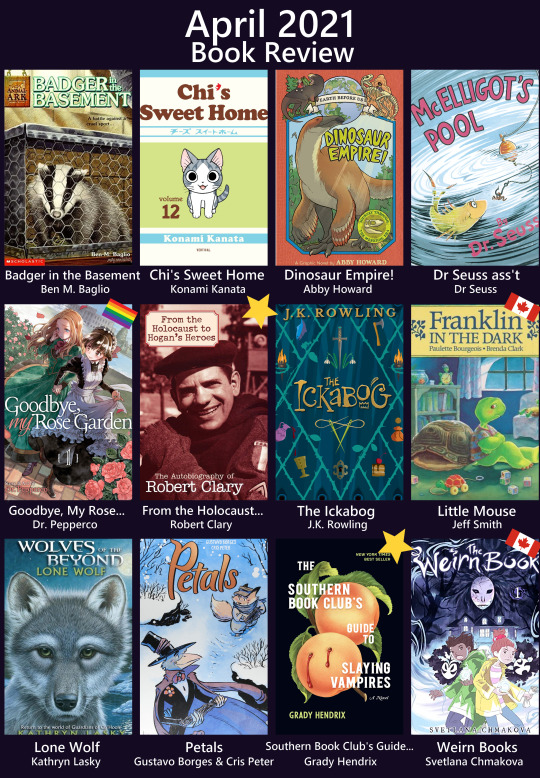
April l was apparently the month for me to revisit some children’s authors who are steeped in controversy at the moment. So here’s my hot (well, lukewarm) takes on issues that absolutely do not need a single other person talking about them. Also some actual good books that I read this month!
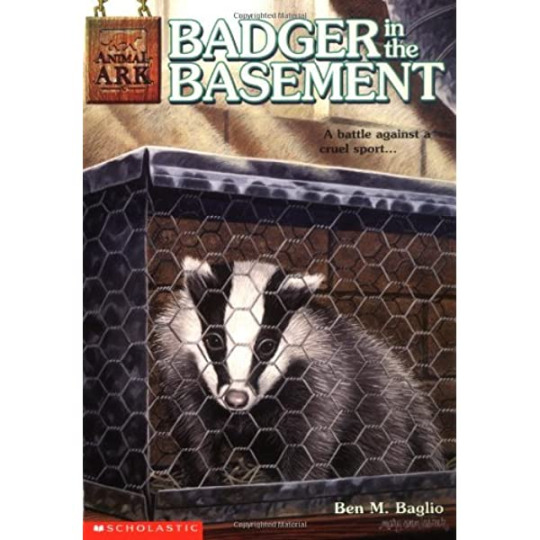
Badger in the Basement
The Animal Ark books are a childhood classic — though I recently found out that apparently there’s a difference between American and British publications, and the American versions didn’t include a lot of actual COOL animals which is… bizarre. As a Canadian stuck in the middle of this, this nonsense drives me nuts. This one was about the main character, the daughter of pair of vets, trying to protect a local badger sett from men wanting to participate in badger digging and baiting. These books are always feel-good, and it was a nice single-day-read while I waited for a library book to come in.
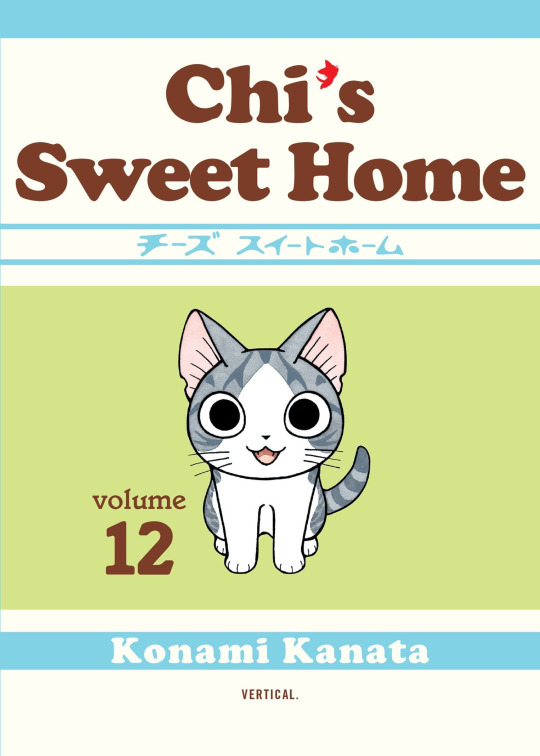
Chi’s Sweet Home
The cutest manga series about the misadventures of a little kitten, Chi, who has been adopted by a loving family. I’ve never bothered to read them in order, but apparently this time I stumbled across the last in the series -- whoops! Still, stood on it’s own pretty easily, and it was a fun read! Things get tense when the family realize that they may have found Chi’s original home… and may have to give up Chi forever.
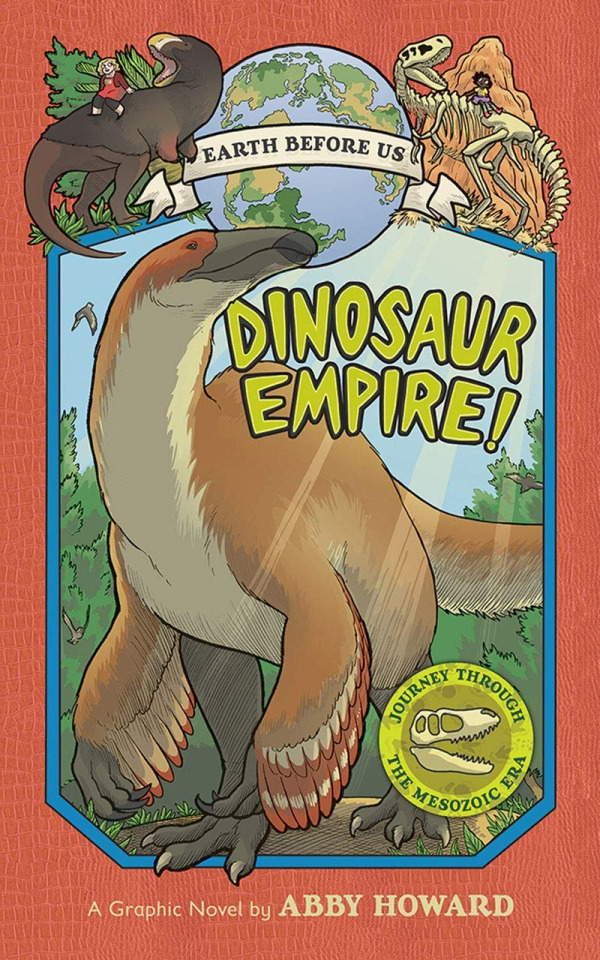
Earth Before Us: Dinosaur Empire!
This was an odd graphic novel, I feel like I’m not sure who the target audience was exactly. It was a nonfiction comic done in a Magic School Bus style, with the purpose of teaching current, up-to-date facts about the animals that lived in the Mesozoic Era. If you’re into dinosaurs, you’ll probably enjoy this! The art is absolutely adorable, I love the dinosaur illustrations, and I learnt some really neat facts. That being said, the pages are really dense, and there’s a lot of info crammed in… some of it will probably go way over a child’s head without specific additional teaching or a very strong personal interest. But that being said, a dinosaur obsessed kid is still probably going to really dig this… as would a dinosaur obsessed adult. It wasn’t my cup of tea exactly but I’m sure it is someone’s.
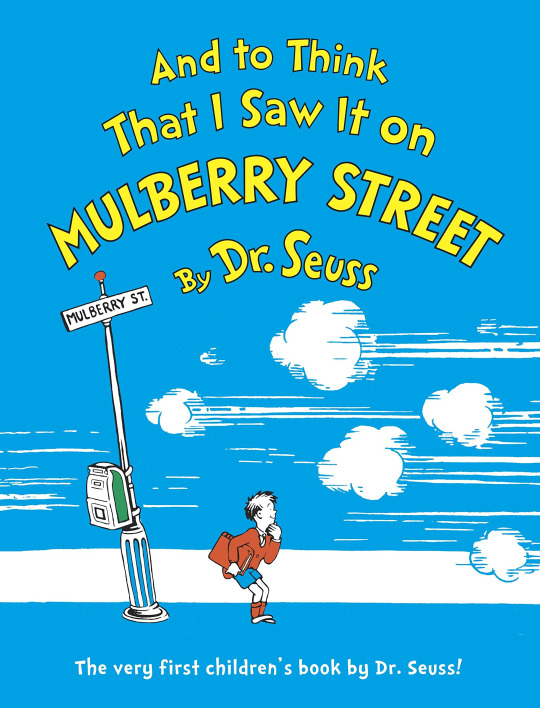
assorted Dr Seuss Books
I love these types of controversies because it means getting to listen to every moron who has never had an opinion on Dr Seuss ever start generating a mile of them out of the aether. So many people are so mad about the six books that are getting retired and I bet most of them haven’t even read them. These are not the friggin Cat In The Hat or The Lorax or even the likes of Yertle The Turtle. I was raised by a grade one teacher, was a voracious reader who loved Dr Seuss, and wrote my university thesis on children’s literature, and I still only knew two of the six books on that list. So by all means, if you want to write an essay explaining why those specific books are worth clinging to, feel free, but if you haven’t even heard of them maybe it’s not a big deal. *grumble*
Anyway, my grousing aside, it gave me the urge to reread a bunch of Seuss books, including the two retiring books I personally knew: McElligot’s Pool and To Think That I Saw It On Mulberry Street. I do still enjoy both, especially McElligot’s Pool which always sparked my imagination, but it’s obvious why they’re being retired and I personally think it’s the right choice. There’s so much good kidlit out there, we can survive without these.
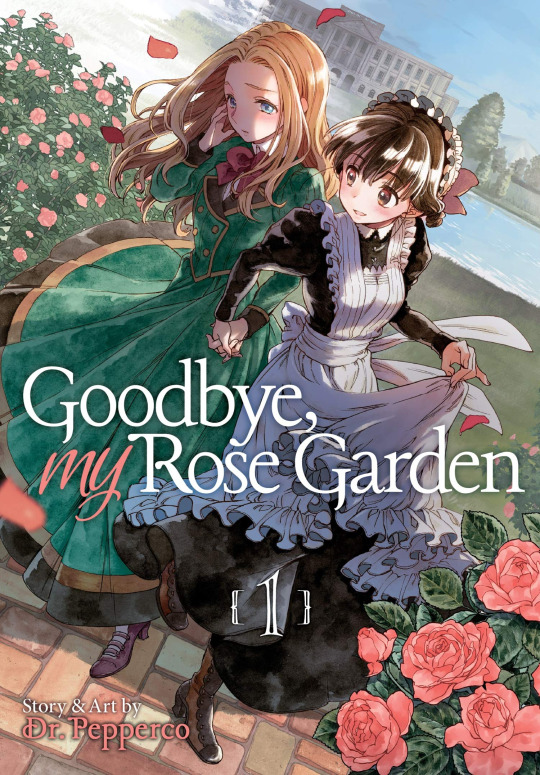
Goodbye, My Rose Garden
A f/f romance manga, fairly standard fair though cute if you’re looking for some historical angst, pretty dresses, and mutual pining. A young Japanese woman moves to England in the hopes of meeting a writer (Mr Frank) who she has long admired. Along the way she is employed by an enigmatic woman with plenty of money, rumours, and melancholy following her. I’ll be honest, uncut romance isn’t really my genre, but I’ll probably still try to the second book to see if the story picks up.
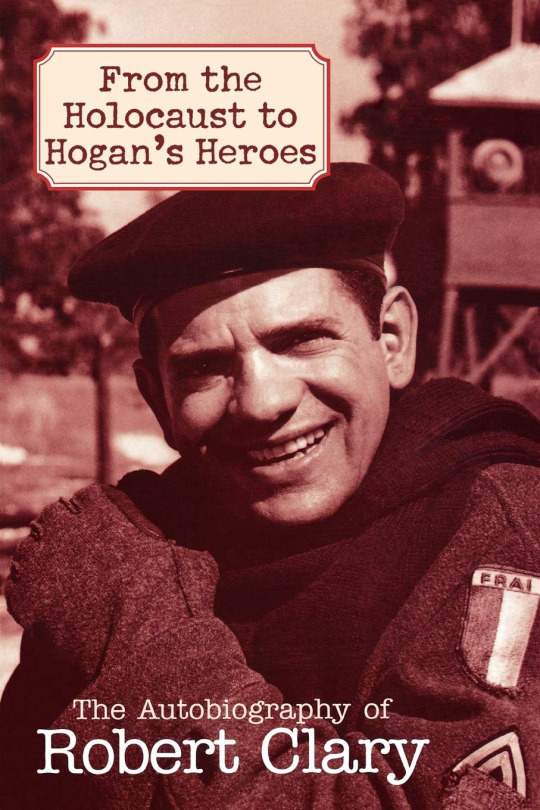
From The Holocaust to Hogan’s Heroes: The Autobiography of Robert Clary
It’s no secret that I’ve been on a Hogan’s Heroes kick. This is the autobiography of Roberty Clary, who plays my favourite character in the show, Louis Lebeau. And holy shit what a life this man has had. He was a Jew growing up in France before the start of the war, and who was one of many children taken away from his family and sent off to the concentration camps in Germany. This was an amazing, intense, inspiring, and heartbreaking read… it has Clary’s voice all over it, and it tells everything from the charming childhood he had, to the horrors of the concentration camps, the brutality of survival, and then about his exciting journey into the entertainment industry afterwards. It’s an experience, would recommend if you’re a fan of the show.
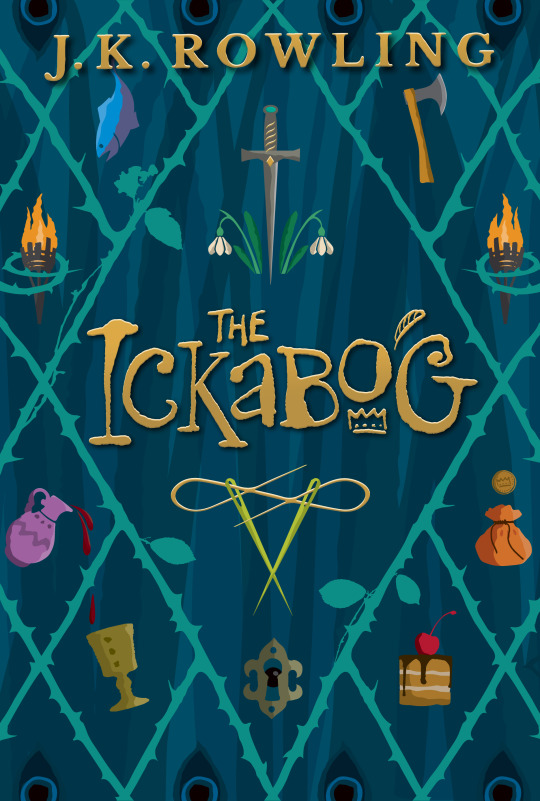
The Ickabog
The second controversial author I read this month. Originally I was going to give Rowling’s new book a miss, given everything that’s been going on over the past few years, but in the end my curiosity got the better of me. Politics aside, it was a fun read! Not groundbreaking, but enjoyable enough and written in an interesting style. It didn’t read the same as a lot of modern kidlit, it felt more like a cross between a classic fairytale and a Dahl book. Perhaps a bit like Despereaux. It tells the tale of how an idyllic country gradually falls into ruin through the ignorance, inaction, and greed, and how a supposedly fictional monster hides the very real, human monsters at the heart of the country. It was cute and pleasant and I’m glad I decided to get it from the library, though for anyone who is choosing not to engage for political reasons: you aren’t missing anything major.
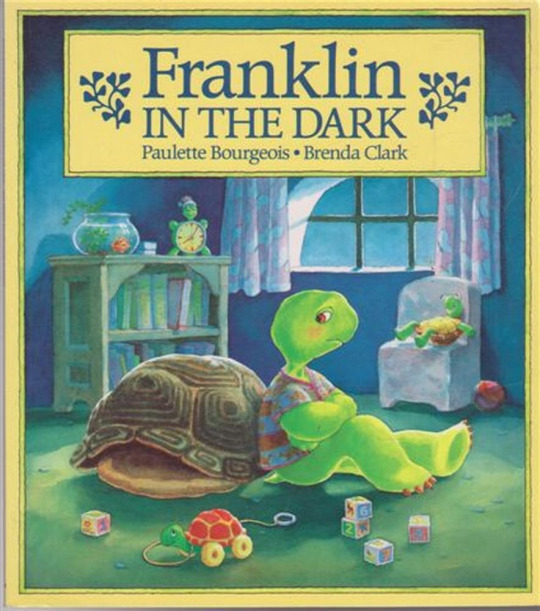
Franklin In The Dark
A Canadian classic. I don’t think there’s a single person my age who hasn’t read or been read a pile of these books, and the nostalgia is so comforting. I found this on Youtube and listened to someone read it to me, and honestly 10/10 would recommend for a calm evening.
The big reason I decided to seek this one out though, was because I finally got to the M*A*S*H episode that inspired this entire series! In the episode C*A*V*E, in which Hawkeye is freaking out over his claustrophia while the camp is forced to take shelter in a nearby cave during some intense shelling, he mentions that if he had been born a turtle he would have been afraid of his own shell, and that the other turtles would make fun of him cause he’d be forced to walk around in his underwear. And so this first story about a young turtle who’s afraid to sleep in his own shell and drags it around behind him. So if you were ever curious, Franklin the Turtle is in fact named after Dr Benjamin Franklin Pierce. (this is also why the French version is named Benjamin!)
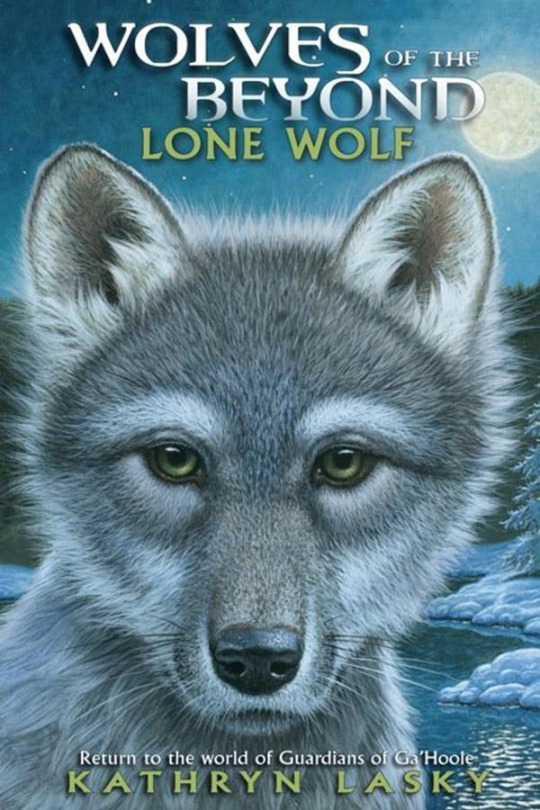
Wolves of the Beyond: Lone Wolf
I loved the Guardians of Ga’Hoole books as a kid but I never read the Wolves of the Beyond series. This first book was an interesting read, Lasky does a great job creating worlds and societies for the animals that inhabit them. Lone Wolf is about a deformed wolf cub who was abandoned in the wilderness to die. And he would have, if a desperate mother bear, who had recently had her only cub killed, hadn’t stumbled across him and saved him, vowing to raise him as her own...
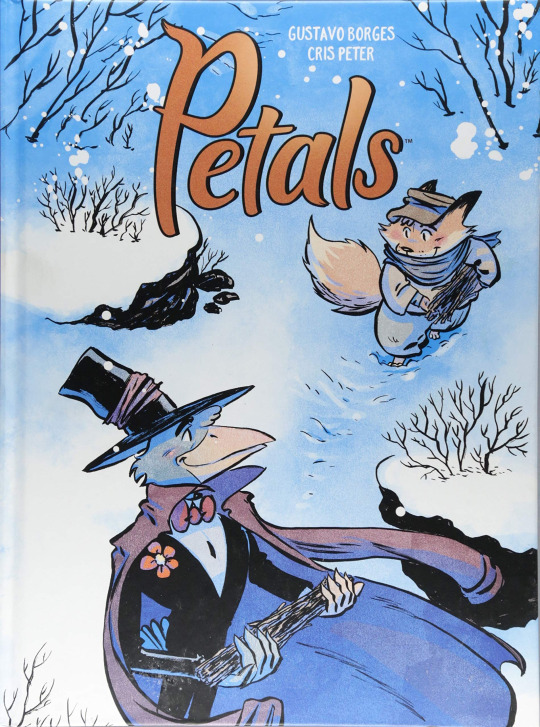
Petals
A “silent” graphic novel. It has beautiful artwork and is told entirely through pictures, no text at all. It’s loves and heart-wrenching, though it left me feeling somewhat unsatisfied… I felt like there should have been more. Still, a neat story.
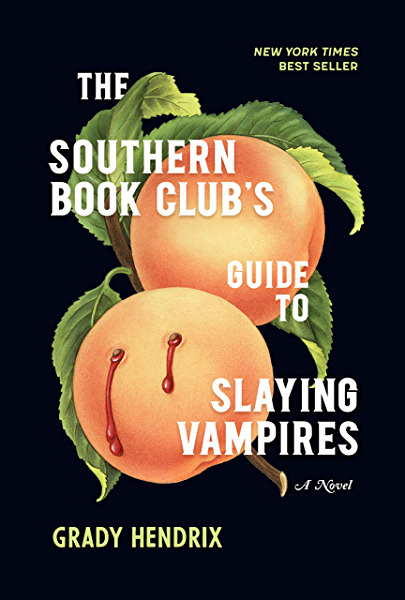
The Southern Book Club‘s Guide To Slaying Vampires
What a banger of a novel!! I can’t recommend this one enough. It’s about a group of suburban mothers in the ‘80s who form a book club out of a shared need for community and a love of grisly true crime novels. But when a strange drifter appears in town and starts setting down roots… and when children begin disappearing… these women need to band together to confront the horrors that have invaded their neighbourhood, and face down not only a terrifying monster among them but the patriarchal system that allows it to flourish. To quote the preface:
“Because vampires are the original serial killers, stripped of everything that makes us human — they have no friends, no family, no roots, no children. All they have is hunger. They eat and eat but they’re never full. With this book, I wanted to pit a man freed from all responsibilities but his appetites against women whose lives are shaped by their endless responsibilities. I wanted to pit Dracula against my mom. As you’ll see, it’s not a fair fight.“
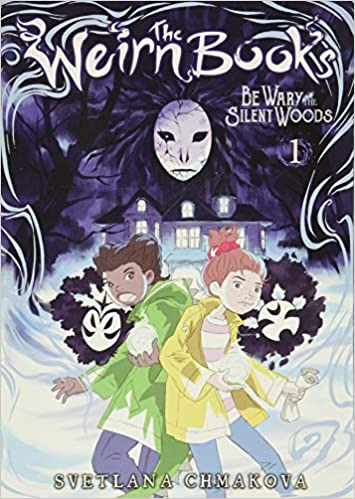
The Weirn Books: Be Wary of the Silent Woods
I love Chmakova’s graphic novels, though I’ve only ever read her slice-of-life middle grade series before. This one is pure fantasy and very fun. It’s about two cousin “weirns” — witches with demon familiars — who attend the local night school. Things get strange though when an ominous figure appears outside the old, abandoned school house deep in the Silent Woods, and begins tempting children down its path…
I’m very much looking forward to word of a second book and was honestly kind of surprised that I haven’t heard more about this book given how popular her other series is. This has all the same charm and quirks but for those of us who prefer stories based in fantasy rather than reality.
And A Bonus...
For some masochistic reason I got a Garfield book out of the library. Jeez, if I didn’t love these as a kid, I found them absolutely laugh out loud hilarious, and now I just don’t see it anymore. But here I will share the one strip in the book that actually made me laugh

#book review#book reviews#chatter#dr seuss#hogan's heroes#robert clary#the southern book club's guide to slaying vampires#animal ark#dinosaur empire#the weirn books#svetlana chmakova#canadian literature#canlit#kidlit#children's literature#wolves of the beyond#mash#franklin the turtle#chi's sweet home#manga#goodbye my rose garden#kathryn lasky#the ickabog#jk rowling
40 notes
·
View notes
Text
Should Have Been Me
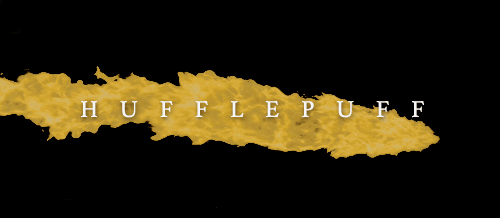
Request: Yes / No (I'm sorry to bother again but I just love your fics so much) could I request another but harry has a twin sister who is a hufflepuff but no one really knows about her she's practically Harry's shadow she was selected in the goblet of fire along with her boyfriend (Cedric) to some attention but doesn't work so when they to the cemetery before Peter kills Cedric she takes the hit know others will miss him more than her and he brings back her body Harry gets devastated for losing his sister @kiss-cult
Don’t be shy, request things! <3 Have a nice day/night
Cedric Diggory x Fem!Potter!Reader
Word count: 2643
Warnings: death and that should be it
Y/N: Your Name
PLEASE DO NOT STEAL MY WORK, I WORK HARD ON MY FICS AND IT’S NOT COOL TO STEAL SOMEONE ELSE’S WORK!
If you want to be on the tag list for anything (My series fics, specific character fics, or just all of them) All you have to do is send me an ask and I will add you!
Masterlist
(Not my photo, credit to whoever made it!)
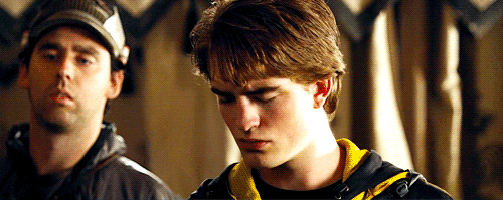
When I first got sorted I was a little upset that I wasn’t in the same house as my brother. Harry was placed in Gryffindor and I was placed in Hufflepuff. Being new to the wizarding world I was kind of scared and nervous. Luckily an older student named Cedric helped me a lot. We became close and Cedric ended up asking me out. I of course said yes and Harry wasn’t happy about it at first. He’s always been the over protective brother, but once he saw how incredibly happy I was he accepted it.
It was the beginning of fourth year and I was sitting in the Great Hall next to Cedric. We may have seen each other over the summer recently, but it wasn’t enough.
“Now we’re all settled in and sorted, I’d like to make an announcement. This castle will not only be your home this year, but home to some very special guests as well. You see Hogwarts had been chosen-” Dumbledore cut himself off as Filch ran up to him. He whispered something to him and ran off again.
“So Hogwarts has been chosen to host a legendary event. The Tri-Wizard Tournament.” He said and people started whispering. I furrowed my brow confused about what was going on.
“Now for those of you who do not know, the Tri-Wizard Tournament brings together three schools for a series of magical contests. From each school a single contestant is selected to compete. Now let me be clear, if chosen you stand alone. And trust me when I say these contests are not for the faint hearted, but more on that later. For now please join me in welcoming the lovely ladies of the Beauxbatons Academy of magic and their headmistress Madam Maxime.” Dumbledore said. The doors opened and a group of very pretty girls dressed in blue danced their ways up the aisle. Butterflies flew into the air and just about every boy was staring at them. They bowed and everyone applauded.
“And now our friends from the north, please greet the proud sons of Durmstrand and the high master Igor Karkaroff.” Dumbledore said. The doors opened again and some older looking boys walked up the aisles holding bo staffs. They were twirling them around and something slamming into the ground, making sparks fly. The girls were staring in awe, well I wasn't, I didn’t much care for them honestly. Once everyone was settled the feast started.
Once it was finished Dumbledore gained everyone’s attention again for another announcement.
“Your attention please! I would like to say a few words. Eternal glory, that is what awaits the student who wins the Tri-Wizard Tournament. But to do this that student must survive three tasks. Three extremely dangerous tasks. For this reason the Ministry has seen fit to impose a new rule. To explain all this we have the head of the Department of International Magic Cooperation, Mister Bartimus Crouch.” He said. Thunder roared above us and it started to rain. Students screamed as they started getting wet. Someone casted a spell at the ceiling and everyone was back to normal.
“Who is that?” I asked Cedric.
“Mad-Eye Moody. He used to be an Aura.” He explained and I nodded.
“Why is he called Mad-Eye?” I asked.
“Well, he lost his eye and leg during the war and he honestly his job just made him lose it.” He said and I frowned.
“How sad.” I said.
“After much deliberation the Ministry has concluded that for their own safety no student under the age of seventeen shall be allowed to put forth their name for the Tri-Wizard Tournament. This decision is final.” Mr. Crouch said and a bunch of students started booing.
“Silence!” Dumbledore shouted and everyone quieted down. Dumbledore casted a spell over a box and it revealed a goblet containing a blue flame.
“The goblet of fire. Anyone wishing to submit themselves for the tournament merely write their name upon a piece of parchment and throw it into the flame before this house on Thursday night. Do not do so lightly, if chosen there’s no turning back. As from this moment the Tri-Wizard Tournament has begun!” Dumbledore explained.
The whole week Cedric was talking about wanting to put his name in. I was worried about him doing so, but I couldn’t stop him if he really wanted to. Luckily he came to me before he made his final decision.
“Well, what do you think?” He asked and I sighed.
“Honestly? I think it’s too dangerous, maybe it’s because this is still kind of new to me but still, it’s really up to you.” I said.
“Do you not want me to?” He asked and I bit my lip.
“I just don’t want to see you die.” I said and he smiled.
“Don’t worry love, I promise I’ll come back to you.” He said and kissed me.
“You better.” I giggled. He quickly wrote his name down and grabbed my hand. He led me through the halls and to the goblet. He ran up and placed his name into the fire. That was it, there was no going back.
The rest of the week I was so anxious. I wasn’t going to be better until they picked names. I could only hope that Cedric wasn’t picked. Thursday came soon enough and we were all gathered in the goblet room.
“Sit down please! And now, the moment you’ve all been waiting for, the champions selection!” Dumbledore said as everyone was taking their seats. Dumbledore approached the blue flame and it started glowing red. A name flew out and I felt my heart rate picked up.
“The Durmstrang champion is, Viktor Krum!” Dumbledore shouted. People cheered as another name came out.
“The champion from Beauxbatons, Fleur Delacour!” He shouted. Peopled cheered as the last name came out.
“The Hogwarts champion, Cedric Diggory!” He announced and my heart clenched. Cedric smiled as he ran up to the front. He grabbed his name and ran into the room with the others.
“Excellent! We now have our three champions! But in the end only one will go down in history. Only one will hoist this chalice on champions, this vessel of victory the Tri-Wizard cup!” He said. Everyone cheered, but the goblet started glowing red again. Another name flew out and Dumbledore silently reads it.
“Y/N Potter. Y/N Potter?” He called and my eyes widened. I looked over at Harry, who looked just as shocked.
“Y/N Potter!” He shouted again and I slowly got up. I walked up to him and took my name from his hands.
“She’s a cheat! She’s not even seventeen yet!” a few people shouted.
“She got Cedric to put her name in!” Someone else said, but I ignored them and walked into the room with the others. Everyone looked at me with a mix of shock and confusion.
“Y/N? What are you doing here?” Cedric asked.
“I-I don’t know. My-” I was cut off by the teachers bursting into the room. Dumbledore grabbed me and my eyes widened.
“Y/N! Did you put your name in the goblet of fire?” He asked.
“No sir!” I answered.
“Did you ask one of the older students to do it for you?” He asked.
“No sir!” I said.
“You’re absolutely sure?” He asked.
“Yes sir.” I answered.
“Well of course she is lying!” Madame Maxime said.
“The hell she is. The goblet of fire is an exceptionally powerful magical object, only an exceptionally powerful conjurer could have hoodwinked it. Magic way beyond the talents of a fourth year.” Mad-Eye said.
“You seem to have given this a fair bit of thought Mad-Eye.” Igor said.
“It was once my job to think as dark wizards do Karkaroff, perhaps you remember?” He said.
“That doesn’t help Alastor. Leave this to you Barty.” Dumbledore said.
“The rules are absolute, the goblet of fire constitutes a binding magical contract. Mrs. Potter has no choice, she is as of tonight… a Tri-Wizard champion.” He said and my eyes widened. Cedric and I went back to the common room and everyone was giving me a nasty glare.
“Ignore them.” Cedric whispered and took me to my room.
“Did you actually put your name in?” He asked.
“No! I’ve been so terrified for you, I would never even think about putting my name in!” I said and he nodded.
“Alright, I believe you. I just had to ask.” He said.
“I don’t want to do this Ced.” I said.
“I know, but you have to, love.” He said and kissed my head.
The first two trials weren’t the easiest. Cedric had helped me prepare, but I was alone in this. I had managed to survive until the last challenge. Everyone was gathered outside at an arena and music was playing like nothing bad was about to happen. The champions walked out, along with myself. My nerves were at an all time high.
“Earlier today Professor Moody placed the Tir-Wizard cup deep within the maze. Only he knows its exact position. Now as Mr. Diggory-” Dumbledore was cut off by people cheering.
“And Mrs. Potter tied for first position they will be the first to enter the maze. Followed by Mr. Krum and Mrs. Delacour. The first person to touch the cup will be the winner. I’ve instructed the staff to patrol the perimeter, if at any point should a contestant wish to withdraw from the task he or she need only send up red sparks with their wands. Contestants, gather round.” He said and we all walked over to him.
“In the maze you’ll find not dragons or creatures of the deep. Instead you’ll face something more challenging. You see, people change in the maze. Oh find the cup if you can, but be very weary you could just lose yours;ves along the way.” He said and I became more nervous.
“Champions! Prepare yourselves!” Mad-Eye said. Cedric hugged his Father and I hugged Harry.
“Be safe.” He said and I nodded while I bit my lip.
“I’m scared Harry.” I whispered.
“Hey, you can do this.” He said with a reassuring smile.
“Harry’s right, you’re strong.” Cedric said coming over to us.
“I’m so scared.” I said.
“Hey, you got this, love. You can win this.” He said and I smiled slightly.
“Don’t go easy on me, Ced.” I said and he smiled.
“I wouldn’t dream of it.” He said and pecked my lips. Harry went up went up to the stands while Cedric and I went to out starting spots.
“On the count of three… One-” Dumbledore was cut off by the cannon going off. Cedric and I entered the maze and I watched the walls close behind me.
As I was walking through everything was making me anxious. There was a heavy mist and there were noises all around me. While I was walking I noticed Fleur was on the ground unconscious. She was slowly being swallowed by the walls and I started panicking slightly. I shot up the red sparks and hoped that someone would save her. I kept walked through the maze and noticed something shining in the distance. I started towards it and someone tried to hit me with a spell.
“Get down!” Cedric shouted and I ducked. Cedric hit him with a spell and ran up to him, kicking the wand from his hands. He pointed his wand at Viktor’s body and my eyes widened.
“No stop! He’s bewitched Ced!” I said. Cedric wasn’t himself. The two of us started to struggle.
“Get off me!” He growled.
“He’s bewitched!” I said again. He pushed me off him and the two of us started running towards the cup. The undergrowth grabbed Cedric and he fell to the ground. I looked at Cedric and I froze in fear.
“Y/N!” He called. I quickly gained the courage and sent a spell to the plant that held him. I helped Cedric up and he looked at me.
“You know, for a moment there I thought you were gonna let it get me.” He said.
“Never, I was just scared.” I said.
“Some game huh?” He asked.
“Yeah…” I said with a sigh. The wind started to blow and Cedric pushed me towards the cup.
“Go! Take it, you saved me!” He said and I shook my head.
“Together, on three. One, two, three!” I said. We both ran towards the cup and grabbed it at the same time. The cup ported us somewhere and we landed on the ground.
“You okay?” He asked.
“I think so, are you?” I asked and he nodded.
“Where are we?” He asked. I looked around and noticed we were in a graveyard, it looked just like the one Harry and I have been dreaming of…
“I’ve been here before…” I whispered.
“It’s a portkey. Y/N, the cup is a portkey!” Cedric said.
“I’ve been here before in a dream. Cedric, we need to get back to the cup, now!” I said.
“What are you talking about?” He asked, grabbing me by the shoulders. I felt a sudden pain in my head and I groaned in pain as I held my scar.
“What is it?” Cedric asked, his voice filled with concern.
“Get back to the cup, please!” I begged. Wormtail walked out holding what I could only assume is what’s left of Voldemort.
“Who are you? What do you want?” Cedric asked, getting ready to protect me.
“Kill the spare.” I heard Voldemort’s voice said.
“No!” I shouted before he could cast the spell. I jumped in front of Cedric and the spell hit me.
Cedric’s POV
Y/N was dead. She took the curse that was meant for me. She sacrificed herself for me.
“You idiot!” The creepy voice hissed. The man who was holding something walked closer and he trapped me with a tombstone.
“Do it quickly.” The voice said and the man dropped something into a cauldron.
“Bones of a Father, unwillingly given.” He said. A bone hovered over to the cauldron and was dropped in.
“Flesh of the servant willingly sacrificed.” He said and cut his own arm off over the cauldron.
“Blood of the enemy forcibly taken.” He said and walked over to Y/N.
“Leave her alone!” I growled at him, but he ignored me. He took the knife and sliced down her arm. He quickly took the knife back over to the cauldron and let the drops fall in.
“The Dark Lord shall rise again!” He said. The cauldron burst into flames and Voldemort emerged.
“My wand Wormtail.” He said. My eyes widened. He was back. He looked back at me with a smirk and then over at Y/N.
“Such a shame.” He said looking at her.
“The only reason you are still alive is so you can return her to Harry Potter. Tell him I have returned and I will win.” He said and I was freed. I ran over to Y/N and grabbed the cup. We were transported back to the arena and everyone was cheering.
“Y/N?” I heard Harry asked, and I just cried. Harry ran over and kneeled next to his sister.
“What happened?” He asked with tears falling down his face.
“He’s back! Voldemort is back. It was meant for me, I was meant to die. She jumped in front of me and took it.” I tried.
“This is your fault! You killed her!” Harry cried and clung to his sister.
“I-I…” I couldn’t say anything. I felt like it was my fault. I should have been the one protecting her, not the other way around.
“I’m sorry Harry.” I cried.
“Sorry won’t bring back my sister!” He shouted. He was right. Y/N was gone and it’s all my fault…
Tag list: @les-bio-lie @tashy-bear @ashwarren32 @hollie-blogs @schisbro87 @lover-of-books-and-teas @nerdygaloresposts @teenwolfbitches2 @genius2050 @drw0301bieber @lady-of-lies @ravenmoore14 @ravenempress101 @cillianchamp @rowanthomasknapp @in-slytherin-we-trust @accio-rogers @sambucky8
#harry potter imagine#harry potter and the goblet of fire#cedric diggory#cedric x fem!reader#cedric diggory x fem!reader#harry potter x sister!reader#cedric x potter!reader#cedric diggory x potter!reader#fanfic#request#hufflepuff#hufflepuff!reader#cedric x hufflepuff!reader#harry potter x hufflepuff!reader
244 notes
·
View notes
Video
youtube
Race in America: Giving Voice with Daveed Diggs
Actor and rapper Daveed Diggs is co-creator, co-executive producer and writer of the new television series “Blindspotting,” based on the 2018 movie he starred in. On Thursday, July 1 at 11:00am ET, Diggs joins Washington Post Live to discuss his versatile career, the frequent themes of race and class in his work and why he looks to the words of Frederick Douglass on July 4 as the country marks its independence.
Transcript under the cut
Race in America: Giving Voice with Actor, Rapper & Producer Daveed Diggs
By Washington Post Live, July 1, 2021
MS. GIVHAN: Hello, and welcome to Washington Post Live. I’m Robin Givhan, senior critic at large. And welcome to today’s installment of Race in America, where I have the pleasure of speaking with actor and rapper Daveed Diggs. As you saw in the introduction, he serves as the co-creator, executive producer, and writer of the new series “Blindspotting.”
Welcome, Daveed.
MR. DIGGS: Thank you, Robin. How's it going?
MS. GIVHAN: It's going very well. I understand that you are in Vancouver, where I hope you're getting normal Vancouver June/July weather and not horrible heat waves.
MR. DIGGS: Oh, no, it's been full-on heat wave, like 110 the other day. It seems to be cooling off a little bit. But, yeah, it's been intense.
MS. GIVHAN: I'm sorry. Well, I hope it cools down.
I want to start, obviously, talking about the series "Blindspotting," which is not a sequel to the film but really sort of is--spirals off the film, so to speak. Can you tell us a little bit about the relationship between "Blindspotting" the TV series and the film?
MR. DIGGS: Yeah. I mean, when this opportunity came along to expand the film into a TV series, Rafael Casal and myself, who co-created the--and wrote the film, we just sort of had to ask ourselves what--if and how we wanted to dive back into this story.
And one of the things we always lamented about the film was the lack of time we were able to give to the character Ashley played by Jasmine Cephas Jones, because we think she created a beautiful character who was reminiscent of a lot of the strong women we grew up around in the Bay Area. And we wanted to see more of her, but a film is so focused, we really had to be inside Collin's head for most of that film. So, we decided to use the TV show as an opportunity to really recenter the narrative on that character, and then, by virtue of it being a TV show, get to explore kind of broader section of the Bay Area than we were able to do in the film. So, try introducing a bunch more characters that we wouldn't have gotten an opportunity for in a 90-minute film, and also just kind of see more of the situations in areas that inspire us and that we grew up around.
MS. GIVHAN: Well, we have a clip from the show that I think really gives people a great sense of the tone and of Ashley, who plays a woman whose longtime partner is recently incarcerated. And then, we can talk a bit more about--particularly about this clip but also about the many layers that I think speak to us in this clip. So, let's take a look at it, and then we'll talk about it more after.
MR. DIGGS: Great.
[Video plays]
MR. DIGGS: Woo, come on, Jasmine.
MS. GIVHAN: To me, that clip--that clip really seems to encapsulate issues of race, gender, class. I mean, it touches on the criminal justice system. Can you unpack that a little bit and just sort of talk about some of the things that are running through that particular scene?
MR. DIGGS: Yeah. I mean, it's sort of the climax of the second episode, so there's a lot going into that. But so, Ashley, Jasmine's character, works as a concierge at an upscale hotel in San Francisco that we named the Alcatraz, because it's funny. And she--so, this day she just found out that her partner Miles is going to be sentenced to five years on a--on a first-time drug conviction while, you know, she overheard the lawyer for another presumably, like, rich wealthy client talking about how they got them a slap on the wrist for a similar thing. And that later at the hotel, that same lawyer shows up and asks her if she'll come sleep with him while his wife's out. And then, later on his wife comes and asks her to see if she could find drugs for her.
So, it's a really terrible day for Ashley. And she decides after that final altercation that that's the last straw and she's going to take it out on the room that that couple is staying in at the hotel. So, you know, it's--it is the moment in the show--it's really the first time--Ashley is really holding it together all through the first episode, and through much of this episode she's not--they have a young son, Sean, and she's really holding it together for him. She's had to move into Miles' family's house with some people who she's not used to living with, who have very different ideas of how to raise children. There's a lot going on. And this is one of the few moments where Ashley really lets it out. We've established this convention of direct address in verse, and so that are really the glimpses that we get into Ashley's inner monologue. Because she is such a composed character, those are the only times really that you get to see what and hear what's going on inside of her. So, this is her moment where she gets to elaborate on all of the frustrations that are happening at the moment and try to get herself a little bit of payback, take the little bit of power that she can get in that day. And it's not--you know, it's not pretty. It's not--and it's maybe not the most sensible thing to do, but it is the choice that she made in that moment. And so, that's what's happened.
MS. GIVHAN: Two things struck me about her response, and one is that she is, you know, playing against this idea of, you know, sort of strong Black woman, strong women of color, and she is showing vulnerability and hurt. And she also is angry and, you know, sort of the idea that a lot of, you know, people of color, whether Black or Latina, you know, are not allowed to express that in--you know, freely is at issue. And she is doing both of those things.
Were those ideas important to you, or were you thinking about those sorts of things in that moment when that was happening?
MR. DIGGS: Yeah, absolutely, absolutely. We wanted all of that to happen. We wanted Ashley to have a moment of anger, and we didn't want to really temper it with a lot of forethought or a lot of--we don't get to see women at all, in particular women of color do that on television very often. And it was important to us to give Ashley this moment where she could really be violently angry, and we tried to create a circumstance where hopefully at least some people who are watching are right there with her.
We try to put you in her headspace enough where you're actually, even though you know there's parts of it that are wrong, are rooting for this to happen and understand that expression of pain that's really there for all of us who have endured anything like this who have, you know, family members incarcerated who have had to--you know, who have had to put our lives on hold because of situations outside of our own control or who are, you know, forced to be demeaned in jobs by people who don't, you know, recognize the--who aren't aware of their own power or their own privilege.
So, yeah, we--it was very intentional, and also to give Jasmine that moment as a performer, as an actor to really do that, was important to us, too. A big--a big part of this process was us trying to find things that Jasmine hadn't been allowed to do yet. When you have a great actor, you get to write for them, and we have that, so--
MS. GIVHAN: The other part of the series that's particularly interesting is that it is so filled with the voices of women, very different kinds of women. And you know, the two co-creators are these two guys. So, I'm wondering how you step into that headspace. I know that you mentioned earlier that when the show was pitched, you--it was one of the rare times when you were sitting across from a woman of color in a pitch meeting. So, I'm wondering if that plays and has played into the way in which the women are portrayed, or you are allowed to portray them.
MR. DIGGS: That's interesting. I mean, we rely on the women connected to the project a lot. So, Kathryn Tyus-Adair stars--is our--the executive who's really been championing us there and has fought for so many things for this show. And we are eternally grateful for her fight, and for her notes, which are always really smart. Our writers' room consisted of mostly women, and that was really important to us.
We also just really leaned heavily on our cast and getting responses from them and changing things when they told us that it didn't feel right. Yeah, so we--Rafael and I tried to be as aware as we could of our blind spots and get as much help as possible to really flesh out these characters and get to know them. And you know, the fun thing about television is once you do that, once you really know them, it's just about putting them into situations and figuring out how they would respond, you know? You get many opportunities to do that. But, yeah, we had a lot of help and tried to create an environment, particularly Rafael as showrunner, to make a place where we needed everybody's ideas on this, you know?
Yeah, episode three was directed by Aurora Guerrero who is, you know, from the Bay, so her perspective is particularly important, and also a woman of color. And you know, even her coming in and helping to sort of refocus some of the ways that we were shooting things were lessons that we took on from there, you know? So, just trying to never assume that we know everything, and when you get the opportunity to be surrounded by brilliant artists, you really want to use them, you know? So, we had great people, and we used them all the time.
MS. GIVHAN: In this process, have there been things that you've learned about the way in which women process stress or frustration or injustice that has surprised you, or just sort of been sort of something that is--that really wasn't on your radar?
MR. DIGGS: That's interesting. I mean, it's hard to pinpoint one--like a--like a lesson I learned or something like that.
But I think what has been really useful for me, or something that--an opportunity that I'm very grateful for is to have had this time--you know, as an actor, which is most of what I do, you get really deep into the headspace of one person, and that's your job, right? I'm only responsible for this one character, and for me that's always been a male character. And when you write, you get to take on the emotions and the headspaces of whoever you're writing for. To get this sort of focused time to sit in the heads of women was something that, I think just made me sit in a little bit--things that I was always aware of but didn't really ever have to sit in, you know? The difference in the social acceptability of the expression of anger--right?--for example. If I were to flip out on set today--right?--I'm--no one's probably going to come back to the press or to my people talking about like I'm difficult or I'm this or I'm a whatever, right?
But that's not necessarily true for the women of my show. If they were to express frustration about things, the response to that is very different, right? And so, getting to sit in that, the kind of--the kind of handcuffs that--the kind of like societal handcuffs that exist for women is--it's time that I'm grateful for and that I think that is the thing that I noticed a lot in writing, is finding moments to break those are really important.
And the spaces where women could talk to each other on the screen where they didn't have to be--where they--where they were allowed to be less aware of the gaze of--like the male gaze that always exists on them became really important because it was the only times where you could really have them free to not--to sort of release those shackles. And that, I think is--anyway, speaks to something that is true of life, I believe, also, but we see woefully rare--like, little of in our, like, televised art.
MS. GIVHAN: You've talked a lot about the importance of representation and how that sort of figures into the way that you think about your work. And you've become thought of a little bit as sort of, you know, a historian because of your work portraying--
MR. DIGGS: Is that true?
MS. GIVHAN: Well, you know, Thomas Jefferson, Frederick Douglass, you've played some pretty significant people from history. And in the process of that, do you feel like you have learned things that you take forward from the past into the way that you understand what is going on in the country now, what's going on in the culture now?
MR. DIGGS: I will say that the historical figures I've had the good fortune to portray are thinkers and speakers and writers for the most part. So, they're people who left a lot of their thoughts behind for us to look at.
The ways that they were critically examining the political structures that they lived in are really--those are the things that I kind of take with me as something to aspire to or something to stop being so afraid of. We seem to at this moment be really hesitant to allow anybody, but particularly our public figures, to criticize the country we live in--right?--particularly in the U.S. and to be critical of it. And I think that's a mistake. And I think these people that I've played knew that it was a mistake.
And like, it's not like I agree with most of the shit Thomas Jefferson was saying, you know? But he was hyper critical of the country and felt that it was his responsibility to be that, you know? Thomas Jefferson was in favor of reexamining and potentially changing the Constitution on a regular basis as the country changed, right? But now, we use him to justify kind of strict constitutional fundamentalism that, like, he wouldn't have supported. So anyway, those are the--those are the things that I take with me.
But the other thing about playing folks from history and getting to do a lot of research is that you realize that history isn't a thing. It is all--it's all--there's a perspective on all of it, right? And we are sort of brought up to think of it as facts. We're not learning facts. You're learning what was intentionally left for you and what's been filtered, right?
So, working on something like "The Good Lord Bird," you realize that, you know, the Daughters of the Confederacy really did a number on how we think about the Civil War and that time period. And there's a very intentional reason why we really don't grow up learning about Harper's Ferry very much--right?--and that we don't know about John Brown generally as much as we should, you know? That's intentional. And those are things that I think it's important to think about when we--when we think about history.
MS. GIVHAN: Well, we should--I should mention that in "The Good Lord Bird," you--that is where you're playing Frederick Douglass. But you also were cited in an adaptation of a famous Douglass speech, "What to the Slave is the 4th of July." And we have a clip of your reciting that. I believe some of it was written by W. Kamau Bell. But if we can play a little snippet of that and then talk about it in a sec.
[Video plays]
MS. GIVHAN: I mean, watching--listening to those words and then watching those images, I think for some people they're very unnerving, disturbing, sort of a rewriting of history, so to speak. And yet, it seems--they seem to really speak to what you were just talking about, this idea that, you know, there is a certain act of patriotism and intellectual rigor to consider facts in their--in their context and not trying to sugar coat them. Was that part of what drew you to that project?
MR. DIGGS: Yeah, absolutely. I mean, you know, filming "The Good Lord Bird" I got to recite Douglass' actual 4th of July speech, which was one of the great experiences I've ever had as an actor.
And then this, a group of my friends who are also my favorite writers had done this adaptation of his speech to trying to premiere it on the 4th of July and asked me to recite it. And they're such brilliant writers, and what they did I think that is so wonderful is just really it is--Frederick Douglass was saying the same thing. And that is a trip. That's a trip when you think about it, because of how little really has changed, that we can still say these same things--right?--despite all of the progress that we've made.
And so, I think you need to look at the context of that progress and what it's really meant and what it really means and how far do we still have to go. And so, I think that's the real usefulness of that piece, besides the fact that it's beautifully written by a lot of my--of my favorite writers. But I think, yeah, that--Douglass' 4th of July speech is one of the greatest pieces of writing I've ever read. And again, being critical, examining critically the system that he was living in, right?
MS. GIVHAN: Our sort of nervousness about looking critically at the country's history makes me think about, you know, your incredible work in "Hamilton" and the way that the reimagining of, you know, the founding story seemed to draw people together, you know, across political aisles, across the political spectrum.
And yet, sort of the subtext of "Hamilton" was in fact this sort of critique of the way in which American history has always been told. Do you see any contradiction between that sort of rallying cry from all quarters about the beauty of "Hamilton" and then the sort of inability to grapple with things in real time?
MR. DIGGS: Yes. But I think that's how art works, right? Again, if you examine the context of when "Hamilton" was made, like, you know, Barack Obama shepherded "Hamilton" into being, right? He was--the first-ever performance of any part of that show was performed at the White House for him.
And I think that era was one where a sort of togetherness and inclusivity was--was--what we were--that was what America was selling, right? That was--up front and center, that is what we were representing. And so, it was easy for people to buy into that, and it spoke to a lot of things that we were feeling as Americans.
It was really interesting having that rereleased on Disney+, the film version we did of it, in the midst of the Trump era, where we had swung so far back the other way and seeing the--still like generally loved but seeing the different lens that people were attaching to it--right--and how I think sort of the more kind of revolutionary undertones of what's going on there were--came a little bit more to the forefront, I think. They were always in there for me when I was working on it. But I think the way I saw it discussed was a little more about the radical potential of inclusivity--right?--and what it really means to have brown bodies take ownership over the creation of our democracy--right?--and what it means for the same democracy to still be failing those bodies.
And so, yeah, I think that--particularly art of marginalized people in this country has always been about how do you--we do this with "Blindspotting," too. It's a comedy for the most part. But we still get to have that moment with Ashley where she gets to say a whole bunch of real shit, and hopefully you're so enamored with her that you sit there and hear all of it and that your ears are open to it. And that's--you know, that's the cakewalk from slavery days, that's minstrelsy, that's all--there's a long lineage of this. That's the Hyphy movement from the Bay Area. That's, you know, the subversiveness of the early days of hip hop. That's all of this. There's a longstanding tradition of people of color using the fact that one of the ways we're allowed to be present and vocal in--is in popular culture in the country. The art has always been a thing that is allowed to move and to spread.
And so, if you can code messages in there, then that's a useful way to do that. I think "Hamilton" is one--there are elements of that in "Hamilton" as there are in a lot of things.
MS. GIVHAN: It sounds like you're feeling the particular power of the arts in this moment. I mean, do you feel like they've sort of moved into a place where they are ever more potent after sort of being silenced for such a long time because of the pandemic?
MR. DIGGS: I think so. Well, I think, you know, the pandemic, I think a lot of us ended up relying on art in a different way. We all--you know, people were stuck inside and needed things to binge watch to distract, you know, to all of that.
MS. GIVHAN: True.
MR. DIGGS: And I think we're in a moment now where there's been sort of a renewed attention to things in a way that--in the different ways that art can be useful, but also just a hunger for it.
We've gotten used to--and now that live performance is starting to come back, you know, that's I think--I hope people are really hungry for that. I know I am. And I think there's a whole different set of experiences there that are really important. So, yeah. I do think there's--we're in a moment right now.
MS. GIVHAN: I'm afraid--I'm afraid we're going to have to leave it there because I've used up all of our time. And I so appreciate the conversation.
MR. DIGGS: Me too.
MS. GIVHAN: And I--thank you for Washington Post Live.
MR. DIGGS: Thank you so much for having me.
MS. GIVHAN: And please come back at 3:00 for my conversation with Karamo Brown for our ongoing series, “The Optimist.” I’ll be talking to him about his mental health advocacy, as well as the power of awareness and optimism. Thank you so much for joining me. And please head over to WashingtonPostLive.com to register and to find out more about our upcoming programs.
5 notes
·
View notes
Note
Krillin for the character ask :)
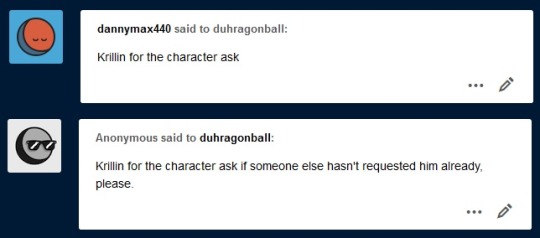
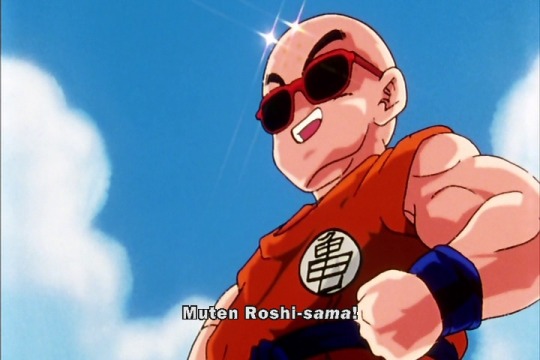
Give me a character and I will answer:
Why I like them: It’d be easy for me to say “he’s just a good dude” and leave it at that. I think people would agree with that statement, but I think it runs deeper than that. The thing that stuck with me about Krillin was when I was checking out the bonus features on the Movie 6 DVD I bought in 2002 or whenever, and they had an interview with Sonny Strait where he explained that Krillin only got into martial arts to impress girls, and that was the same reason Sonny got into voice acting. Maybe I’m misremembering that, but it always stuck with me.
Krillin wants things out of life, and unlike a lot of the other characters, he’s not looking to get them by wishing on a magic dragon. He wants to become worthy of the things he wants, and he may not always be sure of how to get there, he knows that he has to become more than he is.
Recently, I’ve been seeing excerpts from Barack Obama’s book, where he talks about reading up on subjects to try, unsuccessfully, to get girls to like him in college. I think the idea was that he was trying to be self-effacing, but it hasn’t gone over very well. I’m not sure if the problem was that he wasn’t being self-effacing enough, or if there’s something more sinister about reading Karl Marx just in case it helps your odds of getting noticed. I’m not going to wade into that controversy, except to say that it reminded me of Krillin.
Is it shallow to have self-serving reasons to improve yourself? Did I just answer my own question? The point I’m making here is that it’s a useful motivator. Krillin has self-esteem issues, and he joined the Orin Temple and then Kame House to try to overcome them. He thought “If I just get really good at this one thing, then people will like me.” And we can say “Oh, no, it doesn’t work that way, Krillin, people like you because you’re a such a good person, and besides, it doesn’t matter how good you are at martial arts.”
Okay, fine, let’s assume that’s true, and Krillin deceived himself by training in martial arts. Oh no! He put in all that work, and all he got out of it was... being the strongest human on Earth. Shoot. He made himself a better person for nothing.
The reality is that I don’t think he would be as well-liked if he hadn’t gone down this road, simply because people wouldn’t have gotten to know him. That’s really what it’s about. It’s easy to say that you’re liked for “who you are on the inside”, but what people really want is to be noticed long enough to be liked for who they are. And sometimes you gotta take a long look at yourself and say “I need to do something to grab people’s attention.”
And sometimes, in order to motivate yourself into that kind of work, you have to play that trick on yourself. “Just think, if I put in those extra reps in the gym, the ladies’ll be all over me!” And it never actually happens, but it gets you through that workout, and the next, and the next, and the next.
I think we can all relate to that. I’m writing this because three people asked me to, and I’m sort of hoping a few more will see it and like what I wrote. I try to get better, because I like the rush of validation that comes with it. And if I don’t get it, well, boo-hoo, I wrote a few hundred words about Krillin, a subject I enjoy writing about. It’s a no-lose situation, and there’s some non-zero chance that attractive single women might see this and decide to slide into my DMs. It’s a tiny chance, hardly worth mentioning, but it’s a lot higher than if I just sit in my apartment and stare at the wall.
Why I don’t: Ocean Dub Krillin really rubbed me the wrong way, because they wrote and voice directed the character to be really nebbishy. That wouldn’t necessarily make him a bad character, but it definitely conflicted with what you see on the screen, where he’s stepping to Nappa, Vegeta, Dodoria, and everything else he has to deal with. Once Sonny got the role, everything turned out cool. Mondo cool, if you will.
I suppose I should point out the flip side of what I wrote above. Krillin’s so focused on being worthy that he fails to recognize his achievements. That’s admirable in its way, but it also makes you worry about the guy. Like, he knows 18 is crazy about him, right? Wait, does Obama know people like him? Do I? Oh I might have made myself sad there for a minute, excuse me.
Favorite episode (scene if movie):
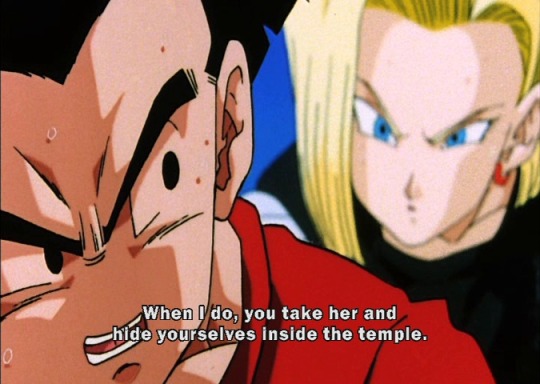
Probably the moment he tries to take on Super Buu all by himself. One of the cool things about Krillin is that he’s taken on every major villain from Piccolo Junior to Buu, despite being outclassed. I think the Super Buu thing is the best one, though, because in that situation there’s literally no chance of anyone jumping in to save him. His entire plan is to hold off Buu for a few seconds and maybe buy a few minutes for the others. He’s doomed and he knows it won’t even work as a diversion, but he still jumps in anyway. It proves that this is who he is. When there’s literally no one left to impress, and nothing left to gain, he’ll still play things out the same way.
Favorite season/movie: The Androids/Cell Saga is probably his best material overall, just because of his conflicted feelings regarding 18, and the difficult choices he makes because of that. You can make a strong case for the Namek Saga, where it’s literally just Krillin and Bulma and Gohan, so he has to take the lead by default, but I’m just not that into the Namek Saga.
Favorite line:
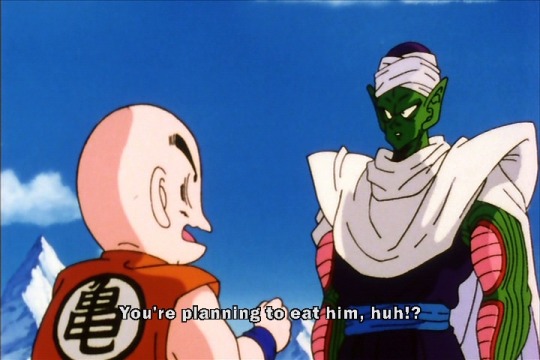
This is really more from one of the video games. I think Budokai 3, but I’m not sure. Piccolo demands custody of Gohan and Krillin’s like “No way, you’re probably gonna eat him or something!” and I’m pretty sure this wasn’t in the Ocean Dub, so it completely caught me off-guard, like it was the last thing I expected Krillin to say. And then Piccolo comes back with “I’m not going to eat him!” like he’s offended at the very suggestion. As a runner-up, I dig that part in DBZA 54, where Trunks and Vegeta are both reeling from their losses to Perfect Cell, and Krillin reminds them that they don’t have to posture around him, because it’s just him... “Krillin. Everyone’s friend.”

Favorite outfit: That’s easy.
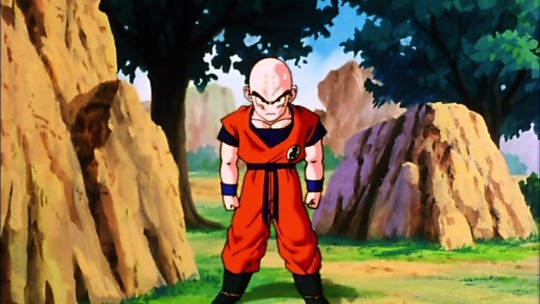
Yeah, the Frieza Soldier armor looked mighty good on this dude, and the cop uniform does too, and the classic Turtle Hermit outfit is a signature look, but this, right here, is the Krillin for me. My man’s got the blue shirt under his orange shirt. No more of the Yamcha slipppers. Those look great on Yamcha, don’t get me wrong, but Krillin needs those big chunky Goku boots, because they’re perfect for stomping those pesky girlfriend-exploding remotes. Fellas, this is the ideal male body. You may not like it, but this is what peak performance looks like.
OTP: Maron HAHAHAHAHAHA oh wow. No. It’s 18, obviously.
Brotp: Clearly Goku is his bro, but it’s not surprising at all how effortlessly he gets along with just about everyone else. He’s bros with the entire world.
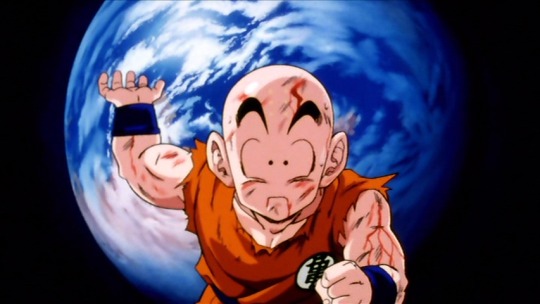
Head Canon: I’m pretty sure the Maron/Marron thing was just a coincidence in real life. Maron the girlfriend was a filler character, and Marron the daughter was introduced in the manga some time later, and both used the same naming convention to end up in the same place. However, I choose to believe that Krillin actually named his kid after his ex, and he somehow convinced 18 to go along with that idea.
By that, I don’t mean he had to sweet talk her into it or promise a bunch of stuff in exchange. I mean he must have discussed what to name their kid, and 18 was like “Your ex-girlfriend? Seriously?” and he was like “Yeah, I know she’s a ditz, but you gotta understand I was in a really low place and she helped me through it.” Or something like that, where once he lays out the whole reason 18′s like “Yeah, you know what? Okay.”
Or maybe Maron helped deliver the baby or something. Or she was the surrogate mother? Holy shit I might be onto something.
Unpopular opinion: Krillin clanks when he walks, due to the solid brass balls he’s got.
youtube
A wish: They should do a movie where Krillin just fights Frieza and wins. Decisively, undisputably, irrevocably. Krillin is stronger than Frieza from that point forward. I don’t care if that means nerfing Frieza or godmodding Krillin, but I just want it made plain that if they use Frieza from here on, it has to be with the understanding that Krillin can whip his ass at any time.
That might sound silly, and I guess it is, but you see what this accomplishes, right? It forces Frieza into a new character dynamic, so it’s not just the same old shit with him. Or Toei collectively admits that they can’t use him anymore, which was what they should have decided in 1995. I’m fine either way.
An oh-god-please-dont-ever-happen: Don’t grow his hair back, okay?
5 words to best describe them: Qualified to sell real estate.
My nickname for them: The Kriller.
23 notes
·
View notes